bellwether
PENN VET PIONEERS
Meet some of the women who paved the way for the School we know today
 UNLOCKING THE MIND’S MYSTERIES DETERMINATION LEADS TO DUAL CERTIFICATION DENTISTRY THAT MAKES A DIFFERENCE
SPRING 2015 #83
THE MAGAZINE OF PENN VET
UNLOCKING THE MIND’S MYSTERIES DETERMINATION LEADS TO DUAL CERTIFICATION DENTISTRY THAT MAKES A DIFFERENCE
SPRING 2015 #83
THE MAGAZINE OF PENN VET
Witnessing Women’s History
Dr. Joan O’Brien, V’63, had fun while making history. As noted in Penn Vet’s 1963 Scalpel yearbook, she was “the first student who was a mother of three children.” This was quite unconventional for a woman at the time. But that was Joan: she was going to do what she liked!

Fast forward to 1974: Along with countless other students, I was fortunate to call Joan a mentor. Although the quotas that limited women to two when she was admitted had long been lifted at Penn, they continued at many other schools. Indeed, Title IX was passed in 1972 and is arguably the only mechanism that lifted the explicit discrimination against women in higher education, including veterinary schools.
Joan was the only female full professor when I joined the Penn Vet faculty, and we later became colleagues and friends. A leading respiratory specialist, she provided valuable insight as I researched sleep apnea in dogs. I fondly remember many mornings carpooling to campus together.

Apropos of Women’s History Month, this issue of Bellwether highlights some of the women who, like Joan, led the way for future generations of female vets. While I know almost all of the women profiled (I did not have the honor of knowing Dr. Olive Britt), I was moved to read their stories in more detail. Of course, there are many more women worth celebrating; I hope this issue inspires conversation about Penn Vet’s numerous female trailblazers. In today’s veterinary field where women predominate, it is important to realize how recently women were overcoming explicit and perfectly legal societal barriers.
In 1963, Joan’s graduation year, there were only 277 female veterinarians in the entire United States, according to the Journal of the American Veterinary Medical Association. In Penn Vet’s class of 2014, there were 91 female and 23 male graduates, and the School has long been ahead of the curve. The quota was challenged by farsighted faculty members in the early 1960s, long before Title IX; after Title IX, the tide of women was allowed to flow unobstructed. There were equal numbers of men and women at Penn Vet by 1978 and, by 1985, women accounted for 70 percent of the class.
I find it interesting that some view a predominance of women as a threat. I have experienced tremendous energy, creativity, and excellence among our current mix of students. That said, we must do a better job of encouraging both women and men to enter our field and widely sharing the rewarding, sustainable career paths a vet can take: from practice ownership, to food production, to pharma. Innovation and entrepreneurship are creating new opportunities all the time.
Since my entry into Penn Vet in 1974, I’ve lived through the changes as they unfolded. Prior to becoming Penn Vet’s first female Dean, I was the first woman named to an endowed professorship. As noted by the Women’s Veterinary Leadership Development Initiative, only six of the 30 U.S. veterinary colleges have female deans—and many of us are nearing the end of our terms. We must cultivate a stronger pipeline of female leadership, which has not kept pace with the numbers of women in the field. This is why I began the Penn Vet Wharton Executive Leadership Program early in my deanship.
Students often ask how I juggled my career while raising a family. I first tell them to find the right partner. My husband proposed on the day I got into vet school, and he has encouraged me 100 percent since. I also like to think of Joan O’Brien. She wouldn’t let anything stop her from being a vet, and she embodied delight, independence, excellence—and being herself.
LEARN MORE
Read about Dr. Joan O’Brien and other Penn Vet pioneers through the years by visiting repository.upenn.edu/ bellwether
2 BELLWETHER SPRING 2015 FROM THE DEAN
Joan C. Hendricks, V’79, GR’80
The Gilbert S. Kahn Dean of Veterinary Medicine
Dr. Joan O’Brien, V’63
OFFICE OF ADVANCEMENT, ALUMNI RELATIONS, AND COMMUNICATIONS
Assistant Dean of Advancement, Alumni Relations, and Communications
Carol Pooser
Director of Alumni Relations
Kristen McMullen
Director of Communications
Ashley Berke
Director of Annual Giving and Advancement Services
Mary Berger
Director of Development for Companion Animals

Helen Radenkovic
Director of Special Gifts and Board Relations
Jillian Marcussen
Associate Director of Major Gifts
Neva Graham
Web Communications Manager
Carole Cloud
Communications Specialist for New Bolton Center
Louisa Shepard
Communications Coordinator
John Donges
Development Coordinator for New Bolton Center
Barbara Belt
Special Events Coordinator
Darleen Calahan
Administrative Coordinator
Judith Francisco
Editor
Karen Gross
Contributors
Katherine Unger Baillie
Ashley Berke
John Donges
Karen Gross
Jillian Marcussen
Kristen McMullen
Louisa Shepard
Manasee Wagh
Special thanks to Penn Vet pioneer
Dr. Elaine Hammel, V’60, for her invaluable insights and assistance with this issue.
Designer
Anne Marie Kane
Please address your correspondence to:
Ashley Berke
University of Pennsylvania School of Veterinary Medicine 3800 Spruce Street Philadelphia, PA 19104-6010 (215) 898-1475 berke@vet.upenn.edu

None of these articles is to be reproduced in any form without the permission of the School.
© Copyright 2015 by
about the cover
Pioneering women of Penn Vet’s Class of 1963: (From left) Drs. Katherine Houpt, Elinor Brandt, Jeffie Roszel, and Joan O’Brien (not pictured: Barbara Henderson).

BELLWETHER
You can now read Bellwether back issues dating to the magazine’s beginnings in 1981. The digitization project was led by Sandra Glascock, veterinary library intern, with lots of help from library student workers. Sandra worked with Sarah Wipperman from Penn’s Scholarly Commons to set up the online archive. Visit repository.upenn.edu/bellwether
departments 2 Dean’s Message 22 Events 24 Research Brief 26 Campus Updates 30 Faculty, Staff, & Student News 36 Class of 2018 37 Planned Giving Profile 38 New Overseers 39 Alumni News 44 Calendar WWW.VET.UPENN.EDU/BELLWETHER 3
the Trustees of the University of Pennsylvania. The University of Pennsylvania values diversity and seeks talented students, faculty and staff from diverse backgrounds. The University of Pennsylvania does not discriminate on the basis of race, sex, sexual orientation, gender identity, religion, color, national or ethnic origin, age, disability, or status as a Vietnam Era Veteran or disabled veteran in the administration of educational policies, programs or activities; admissions policies; scholarship and loan awards; athletic, or other University administered programs or employment. Questions or complaints regarding this policy should be directed to: Executive Director, Office of Affirmative Action and Equal Opportunity Programs, Sansom Place East, 3600 Chestnut Street, Suite 228, Philadelphia, PA 19104-6106 or by phone at (215) 898-6993 (Voice) or (215) 898-7803 (TDD). features 4 PENN VET PIONEERS 12 UNLOCKING THE MIND’S MYSTERIES 15 DETERMINATION LEADS TO DUAL CERTIFICATION 19 DENTISTRY THAT MAKES A DIFFERENCE SPRING 2015 #83 THE MAGAZINE OF PENN VET 12 4
15 bellwether contents
DIGITIZED!
HAS BEEN
PENN VET

Meet some of the women who paved the way for the School we know today
 BY KAREN GROSS
BY KAREN GROSS

Spanning various backgrounds, class years, and career paths, these seven women changed the face of Penn Vet and veterinary medicine.
They spoke candidly of their successes and challenges, breaking into a field that has shifted dramatically in just a few decades. Hearing each of their stories first hand, similar traits emerged: courage, diligence, and an unshakeable commitment to the profession, despite naysayers and obstacles. The meaningful encouragement of mentors, both male and female, was a repeating motif.
No story about trailblazing Penn Vet women would be complete without recognizing Dr. Josephine Deubler, V’38, the School’s first female graduate and the first woman to join the faculty. Dr. Deubler was the cover subject of the Spring 2002 issue of Bellwether featuring distinguished alumnae (No. 52). We encourage you to learn more about her by visiting the Bellwether online repository at repository.upenn.edu/bellwether
We hope these stories spark a conversation about the many pioneering Penn Vet women, including those we have yet to feature.
4 BELLWETHER SPRING 2015
Women of Penn Vet’s Class of 1963: (From left) Drs. Katherine Houpt, Elinor Brandt, Jeffie Roszel, and Joan O’Brien (not pictured: Barbara Henderson).
Dr. Olive Kendrick Britt

The late Dr. Olive Kendrick Britt broke ground as a woman in equine medicine and surgery—a field she didn’t even enter until her forties. Growing up on a ranch, she deferred her dream of becoming a veterinarian for many years. After graduating from the University of Georgia College of Veterinary Medicine at age 42, she was accepted in 1959 as the first female intern-resident at Penn Vet’s large animal clinic. Only one veterinary school graduate was accepted annually to the competitive position.

Britt’s story is inextricably linked to that of the late Dr. Charles Raker, a founding father of New Bolton Center, where he served as Chief of Large Animal Surgery for nearly 30 years and championed female veterinarians. Raker went to bat for Britt—first during the internship admission process and later on, with clients reluctant to see a woman vet.
In the book Women in Veterinary Medicine: Profiles of Success by Drs. Sue Drum and H. Ellen Whiteley (Iowa State University Press), Britt noted, “Although I had many fine teachers, Dr. Charles W. Raker [V’42] is the man most responsible for my success. He fashioned in me the knowledge and confidence to become an accomplished equine practitioner.”

Accomplished, indeed: Britt would go on to become the first female equine practitioner in Virginia and the first woman appointed to the Virginia Board of Veterinary Medicine. With Dr. Milton Kingsbury, she established the Woodside Equine Clinic and cared for the legendary racehorse Secretariat.

Like Raker, Britt nurtured aspiring veterinarians, including Dr. Laura Gay Senk. An accomplished equestrian, Senk was riding in a Richmond horse show in the late 1960s when she met Britt and Kingsbury.
“They were the veterinarians for the show,” recalled Senk, speaking by phone from her home on Long Island. “I followed them around at the show, and they were gracious enough to allow me to come to their clinic and stay to observe and learn on many occasions.”
“Dr. Britt was very methodical and thorough. She explained everything clearly to the client and took time to explain things to me,” she continued.
Senk ultimately enrolled in vet school at Georgia, where she became good friends with classmate Dr. Corinne Sweeney—future Associate Dean of New Bolton Center. One day, Britt returned to speak at her vet school alma mater. “They held her lecture in our main lecture hall, which was quite large. When I opened the door and walked in, it was standing room only,” Senk said. “Her reputation preceded her, and many people wanted to be in the presence of a legend. I felt very appreciative and honored that I had the opportunity to work with her.”
WWW.VET.UPENN.EDU/BELLWETHER 5
and many people wanted to be in the presence of a legend.”
First female intern-resident in Penn Vet’s large animal clinic, 1959
Dr. Katherine A. Houpt
Penn Vet Class of 1963
Dr. Katherine Houpt almost didn’t make it to Penn Vet. “I had a boyfriend who didn’t approve,” she explained. “I was accepted and turned it down, and I spent the whole summer crying.”

After being readmitted in August, “I thought I was taking a vow of celibacy when I went to vet school,” Houpt said. “The mentality at the time was that no guy wanted a girl better educated or smarter that he was.”

As it so happened, Houpt would soon meet her husbandto-be and future research collaborator. “They assigned a faculty member to show us around the Penn campus— and three years later, I married that guy!” she said. Dr. T. Richard Houpt, V’50, wasn’t threatened by her smarts. “He taught physiology, and I studied hard because I wanted to impress him.” For their honeymoon, she quips, “We visited veterinary schools in the U.S. and Canada.”
Houpt was one of five women to graduate in 1963. “I really had a good time in vet school,” she said. Two of her classmates—the late Drs. Joan O’Brien and Jeffie Roszel— had enrolled in their thirties. “Joan and Jeffie were older. They were ladies. I never heard a dirty joke. We were treated nicely.”

“I always make a big point of saying I’m a VMD,” Houpt noted. “Penn did accept me, and many other vet schools weren’t accepting more than two women.” She would earn not only a VMD but, in 1972, a PhD in biology from Penn, followed in 1993 by Board Certification as a charter diplomate of the American College of Veterinary Behaviorists (ACVB). She served as ACVB president in 1999.

Houpt became a leading researcher in animal behavior and welfare, authoring numerous papers as well as the widely used textbook Domestic Animal Behavior, and lecturing around the world. She is most proud of her studies in equine behavior; in particular, the physiological basis of equine ingestive and maternal behaviors.
Although she became the first woman appointed to a full professorship at Cornell’s College of Veterinary Medicine, her initial application for tenure, despite impressive credentials, was not approved. “That was probably the most challenging year of my life,” she said, noting that in the late 1970s and early 1980s “there was still a lot of prejudice against women. But as soon as the barriers came down, they just flocked into the profession.”
In 1978, she wrote about this trend in the article “Equal Opportunity in Action: Veterinary Medicine, A Success Story” for Veterinary Medicine/Small Animal Clinician She also co-wrote two in-depth editorials for The Cornell Veterinarian; the first delved into the history of women in veterinary medicine, while the second explored the field’s current status and promising future.
At Cornell, she served as a Professor from 1989 to 2005, followed by four years as James Law Professor of Animal Behavior. She has been Professor Emeritus of Animal Behavior since 2010.
“Whenever a woman got tenure, I’d have a party for her. I always tried to do things like that,” Houpt said. “I really tried to help women.”
6 BELLWETHER SPRING 2015
“I thought I was taking a vow of celibacy when I went to vet school.”
Drs. Elinor Brandt, Katherine Houpt, and Barbara Henderson (from left to right), all V’63, remain friends more than 50 years after graduation.
On the wall of the hospital at New Bolton Center hangs a plaque honoring Dr. Jill Beech. Her photo caption reads: “Recipient of 2011 AAEP Educator of the Year Award. 39 years as Revered Clinician, Teacher and Scholar, 1972 – 2011.”
In light of her distinguished career, it can be hard to imagine Dr. Beech once feeling out of place at New Bolton Center. “Now, there are more women out here than men. Back then, you were a real minority. I might be the only woman in my group of 12 students in a rotation. And certain clinicians would avoid doing anything with you if you were a woman,” she recalled.
After undergraduate years at UC Davis, Beech arrived at Penn Vet having never been to Philadelphia. She is candid in her recollections of those years. Some clients and trainers did not want a woman to look at their animals. And there were fewer drugs available to tranquilize large animals— so, as a woman, you “really had to rely on guile and intelligence,” she said.
She persevered and found allies at Penn Vet, including Drs. Al Merritt, William Boucher, and Charles Raker. She recalled a now-legendary story about Raker bringing her and two other female interns to the yearly meeting of the American Association of Equine Practitioners: “Dr. Raker was a very highly regarded figure within the organization. He would greet his colleagues and say, ‘I want you to meet my interns,’ and they would immediately look past us, looking for guys. Dr. Raker would say, ‘No, these are my interns!’ The three of us thought he took some delight in doing so!”

Another mentor was Dr. Robert Whitlock, who she said “really encouraged women and helped them with their research.” Coincidentally, in 2010, Beech received the Robert Whitlock Award, presented to the faculty member who demonstrates the most dedication to mentoring young faculty.

Beech served as an instructor of large animal medicine at Penn Vet starting in 1976; received the title of Professor in 1993; and was named the Georgia and Phillip Hofmann Chair in Medicine and Equine Reproduction in 2001. She promoted the clinical services of ophthalmology and neurology at New Bolton Center, and later focused her research on equine pituitary disease and muscle dysfunction. She has published numerous papers in refereed journals, and she has edited and contributed to major equine medicine textbooks. She retired from Penn Vet in July 2011.

In honoring Beech with a distinguished educator award, the American Association of Equine Practitioners noted that she “propelled the careers of countless leaders in the equine veterinary profession.” For Beech, paving the way for others has been just as important as forging her own path.

“I worked hard and no doubt jostled some people along the way. Even though there were few of us at that time, I think it is important to remember that there were other women who preceded me in equine veterinary medicine. One always stands on someone else’s shoulders,” she said.

WWW.VET.UPENN.EDU/BELLWETHER 7
“Now, there are more women out here than men. Back then, you were a real minority.”
Penn Vet Class of 1972
Dr. Jill Beech
Penn Vet’s Alumni Award of Merit in 2011. New Jersey VMA’s Veterinarian of the Year in 2006. Jersey Shore VMA’s Veterinarian of the Year in both 2000 and 1988.
These are just some of the honors Dr. Marilyn Weber has received throughout her veterinary career. And she traces it all back to The Noisy Book by Margaret Wise Brown—a children’s story about a dog who had to visit the vet. “My mother tells a story that, ever since I saw that book, that’s what I wanted to do.”
Weber was undeterred even by permanent paralysis from poliomyelitis, which requires her to use braces and crutches to get around. She credits her parents with supporting her veterinary ambitions and instilling a resilient, cando mentality. And she found a mentor in the family’s vet, Dr. Lloyd Kornblatt, V’47, working in his office in her hometown of Metuchen, New Jersey, during high school. “He was the one who made me believe that I could become a veterinarian,” Weber said. Her guidance counselors, however, discouraged her from applying to veterinary school. “It made me more stubborn,” Weber laughed.
At Penn Vet, nearly two decades before the Americans Disabilities Act of 1990, “a lot of places didn’t have elevators. I remember when we had anatomy, we had to climb three or four flights of stairs.” She recalls being treated her classmates—which is how she prefers it.

“I don’t consider myself a handicapped person. I consider myself a veterinarian first,” Weber said emphatically. She did an externship in lab animal medicine, but her wasn’t in it. “I didn’t really want to sit at a desk or at a bench the whole time. To me, clinical practice was more exciting,” she said.
At the Penn Annual Conference in 1975, she interviewed with Dr. Thomas Sollas, V’56, and took a job with him at Sea Girt Animal Hospital in New Jersey. At the time, she second woman to join the Jersey Shore Veterinary Association. “Now, it’s more women than men,” Weber purchased the practice from Sollas in 1988 it for the next 13 years. “I did a lot of cat work. dogs. And I took care of a couple goats,” she said. she received the SPCA of Monmouth County’s Award for her tireless work with strays.







Weber is a founding member of the Dean’s Alumni at Penn Vet. She has sponsored several full Opportunity Scholarships and is invested in the next generation of veterinarians. Asked why involved at the School, she responds without hesitation: give back to my profession.”
Reflecting on her legacy, she noted, “I think I paved in making people realize that people like me, who be 100 percent physically well, could still have an veterinary medicine. And to me, that means a lot.”
8 BELLWETHER SPRING 2015
“I don’t consider myself a handicapped person. I consider myself a veterinarian first.”
Dr. Marilyn Weber
Penn Vet Class of 1975
Dr. Mattie Hendrick


Penn Vet Class of 1978
Dr. Mattie Hendrick is known as a visionary thinker, noted for providing the first link between vaccination and the development of fibrosarcomas in cats. And she credits Penn Vet with welcoming and fostering her nontraditional, interdisciplinary approach—dating back to her undergraduate years at Vassar, when she was deciding whether to pursue the profession.
“I chose veterinary medicine, and I think I chose Penn Vet at the same time, because my interests had to do more with looking at animals in a comparative biology and behavior way rather than a clinical way. I came from a liberal arts background and majored in psychology. Penn Vet seemed to suit what I wanted to do,” she recalled.

While at Penn Vet, she had an “a-ha” moment during a summer internship in comparative pathology. “I knew immediately that’s what I wanted to do,” Hendrick said, adding, “Pathology even back then was taught by some of the best people at Penn Vet.” She was also inspired by pioneering Penn Vet biochemists Drs. Mary Dwight McNair Scott and Adelaide Delluva, who she described as “a strong role model for many women in the vet school.”
As a female student, “I never felt any oppression or discrimination or feeling inferior in any way,” Hendrick said. “In my opinion, we sort of dominated the class!”

She served on the Penn Vet faculty from 1985 until 2007, rising to rank of Full Professor, but she recalled inequalities

she didn’t experience as some of it was undercover,” she said. Resolute, she trained countless students and residents, headed the Laboratory of Pathology & Toxicology, and served as Director of the Histopathology Laboratory for five years.

Remembering how she came upon her groundbreaking discovery in the 1980s, Hendrick said, “I was reading many biopsies and started to see trends. I noticed that I was seeing this particular lesion over and over, what looked like a vaccination reaction. Six or seven months later, in the same sites, were these tumors,” she said. “My chairman at that point was Dr. Alan Kelly. He was very supportive of me and encouraged me to do more research in it.”
Kelly connected her with Penn’s medical school pathologists to further investigate the pattern, which led to a number of co-authored papers. Hendrick became Chair of the Epidemiology/Pathology Subgroup of the VaccineAssociated Feline Sarcoma Task Force, a joint endeavor of the American Veterinary Medical Association, American Animal Hospital Association, American Association of Feline Practitioners, and the Veterinary Cancer Society.
Winner of the Dean’s Award for Leadership in Education, Hendrick noted that Penn Vet encourages veterinary leaders in various fields. “I really do believe Penn is more progressive than a lot of other schools. They’ve always supported people being self-starters and entrepreneurial.”
WWW.VET.UPENN.EDU/BELLWETHER 9
“In my opinion, we sort of dominated the class!”
Dr. Linda Rhodes

Looking back at a career that has taken quite a few unexpected turns, Dr. Linda Rhodes laughs, “It was quite a ride!”
After turning down a PhD program in theoretical mathematics, she discovered a passion for veterinary medicine while living on a California commune, milking goats. However, “Back in 1973, when I was applying, most vet schools didn’t admit that many women,” Rhodes said, adding, “You had to apply in the state of which you were a resident.”
She had heard that Penn Vet was “gender neutral.” A native of New York, she moved across the state line to the small town of Hop Bottom, Pennsylvania, to become a resident while completing pre-vet courses.
At Penn Vet, “We had a number of strong women leaders, which was unusual then,” she said, pointing to Drs. Joan O’Brien, Elaine Hammel, and Jill Beech as mentors. Hammel, who was teaching field service, was “in her truck, helping cows, and that’s what I wanted to do,” Rhodes said. Even after graduating fourth in her class, Rhodes struggled to find a job as a dairy cattle veterinarian. “I had 17 interviews. I heard comments like, ‘My wife isn’t comfortable with me riding around in the truck with a woman,’ and ‘Physically women can’t do this kind of work,’” she said.

After a short, reluctant stint in a small animal practice, she was finally accepted to a clinical internship at Utah State University. She continued working locally after the internship, focusing on herd health. At the time, she was the only female large animal veterinarian practicing in Utah. Her path led back east to Cornell, where she was asked to teach part-time in the bovine palpation lab. After a sabbatical teaching embryo transfer to veterinarians in Israel, where she was the only female large animal veterinarian in the country, she was accepted to Cornell’s PhD fellowship program in physiology. “I could do research
on ruminants, particularly in reproduction. I enjoyed being in the library and the laboratory again,” Rhodes said.


After earning her PhD, Rhodes pursued a new career direction: pharma. “I saw an advertisement for a pre-clinical biology research position at Merck. They were delighted with my background. There was a real need for people with broad biomedical understanding who could do research on new drug targets.”
She worked on developing human drugs using animal models. “Then, Merck formed a joint venture—an animal health division called Merial. I headed up the clinical research department, focused on drugs for cattle, which was right up my alley,” she said.

In 2001, Rhodes left Merial to co-found AlcheraBio LLC, a consulting and contract research organization [CRO] focused on the animal health industry. “By the time we sold the company, we were running clinical trials for all top 10 animal health companies in the country as well as half a dozen companies from Europe,” she explained. “We pioneered an industry. There was not a big, full-service animal health CRO in the U.S. prior to AlcheraBio.”

Rhodes was about ready to retire when she received an offer she couldn’t refuse: serving as the founding CEO, and currently, as Chief Scientific Officer at Aratana Therapeutics. “I saw this as an opportunity that would completely change the animal health industry. The venture capital investors had discovered animal health and were willing to invest. We have over 20 drugs in development. Aratana has grown exponentially,” she said.
For Rhodes, several paths in veterinary medicine have converged with remarkable synergy. And she provides guidance to women who are finding their way to leadership positions in the animal health industry. “We still need a lot of encouragement for women as they rise up in their careers and encounter less pay for equal work, for example,” she said.
10 BELLWETHER SPRING 2015
Penn Vet Class of 1978
“We still need a lot of encouragement for women as they rise up in their careers.”
Dr. Darcie Stolz

Penn Vet Class of 1982
As the commencement speaker for Penn Vet’s Class of 2009, Dr. Darcie Stolz left the graduating class with this inspiring thought: “If a girl from the suburbs, who knew nothing about agriculture, could end up being the first woman food animal practice owner in the heart of dairy country in Pennsylvania, you can do anything.”
Stolz exemplifies perseverance. Both her high school guidance counselor and college advisor strongly discouraged her from pursuing veterinary medicine as a career. But she steadfastly followed her calling. “I loved animals ever since I was a little girl,” she said.

As an undergraduate at Penn State, Stolz had every intention of becoming a small animal vet. But she volunteered at the sheep barn during lambing season, and that changed everything. Large animal medicine “was just a whole new world. I really liked the people and being outdoors. The lifestyle seemed to fit me.”
With signature stick-to-itiveness, she applied twice to Penn Vet before being accepted on her third try. “I graduated in 1982, at a time when women were still in the minority, and women interested in large animals were few and far between,” Stolz noted. “In fact, in my class of 103 students, I was the only woman who wanted to focus on bovine medicine.”

she found supportive mentors at Penn Vet, going out into workplace was a different story. Many large animal practices not even grant her an interview. She finally found a job in a two-person large animal practice in Lancaster County, Pennsylvania. “I was very fortunate that once I did get hired, boss] was a good mentor and helped me get my feet on the Stolz said.
had to earn the trust of the local Amish population. “My was when I saved the Amish bishop’s cow from death. catapulted my career within the Amish community,” Stolz initiated preventative herd health programs, beginning with scheduled herd checks.”
Stolz purchased the dairy, beef, and small ruminant portion practice, and she has had a thriving business since. “You’ve build up that ‘trust account’ like a bank account,” she said, “As a woman, it took longer and you had to work harder.” credits her husband for his unwavering support. The demands juggling practice ownership with raising children “take a spouse behind you 100 percent.”

the Production Animal Practice Veterinarian At-Large representative to the Pennsylvania Veterinary Medical Association Board of Trustees, and she served on the American Association of Bovine Practitioners Board of Directors for six years. She presented the talk Families, Females and Food Animals: Can We Do It All? at the Association of American Veterinary Medical Colleges’ annual meeting. And she considers speaking at the Penn Vet commencement “one of the highlights of my career.”
All of this might seem impossible to a girl discouraged from pursuing a passion for veterinary medicine. But as Stolz noted in that commencement address, “Remember that even the most unlikely goals can be accomplished. I am living proof of that.”
“In my class of 103 students, I was the only woman who wanted to focus on bovine medicine.”
WWW.VET.UPENN.EDU/BELLWETHER 11
UNLOCKING THE MIND’S MYSTERIES
Dr. Tracy Bale sheds light on how sex differences and stress influence the brain
BY KATHERINE UNGER BAILLIE
THE BRAIN IS A CURIOUS THING. EMINENTLY MALLEABLE, IT ALSO APPEARS CAPABLE OF BEING PROGRAMMED WITH CERTAIN APTITUDES AND LIMITATIONS, EVEN BEFORE BIRTH.
For Dr. Tracy Bale, Professor of Neuroscience at Penn Vet, the brain has long been an intriguing source of mystery. Her curiosity about this complex organ led her to pursue a career focused on how differences in sex and environment can influence its development.
Her work exemplifies a translational approach to research and underscores the importance of the One Health initiative, connecting human and veterinary medicine. By forming partnerships with clinicians in human medicine, she has broken new ground in understanding how the interplay among heritable traits, life experience, and sex may hold clues as to why and how certain neurological conditions—including autism, schizophrenia, and depression—affect men and women differently.
WIRED FOR SCIENCE
“As far back as I can remember, I have been drawn to science,” Bale says. “I remember in 10th grade biology, we had to dissect a fetal pig. Most of my friends
thought it was disgusting. I loved every aspect of it.”
Though Bale long felt a natural pull toward science and majored in biology in college, it was during a stint in a government lab after her undergraduate years that she became certain of her career path.
“That was really where I decided I loved research,” she says. “The idea of, ‘Here’s this mystery: What does it mean? How would you solve it? How would you ask the questions? What do the results mean?’” She recalls her advisor at the time telling her, “You need to go to graduate school.”
At the University of Washington, Bale earned her PhD in pharmacology and neurobiology. She wrote her dissertation on oxytocin—the “feel-good hormone”—in rats, investigating how levels of its receptor are regulated differently in males and females and how that expression may relate to sexual behaviors and anxiety.
When she began her graduate work in 1993, her pairing of molecular biology and behavioral studies was somewhat unusual—a
12 BELLWETHER SPRING 2015
coupling that persists in her lab today. Bale regales students about how she had to log long hours watching female rats strike reproductive postures and performing her own DNA sequencing.
“This was before universities had sequencing cores where the sequencing work is done for you,” she says. “I tell them how I had to pour my own huge gels and sit in a darkroom and go ‘A, T, G…’ and they’re like, ‘No way!’”
After finishing at UW, Bale moved to San Diego to pursue a postdoctoral position at the Salk Institute. She worked under pioneering endocrinologist Dr. Wylie Vale, who focused on how hormones acted in the brain to modulate the body’s responses to stress.
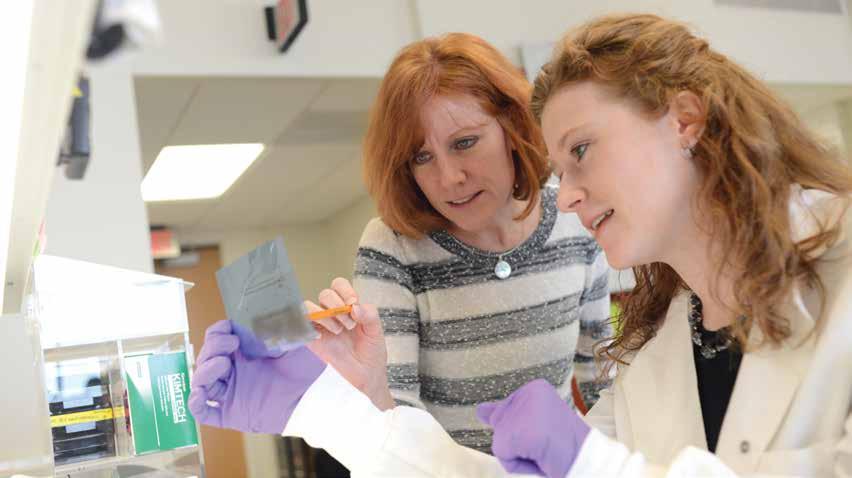
“I brought the sex differences thinking to that project,” Bale says. “To me it seemed the best of all worlds to think about sex differences in the brain and how that manifests into sex biases in diseases like autism, schizophrenia, and depression, which all have huge gender differences in presentation.”
After her postdoc, she briefly considered a career in the pharmaceutical industry. “But I realized that was not for me,” she says. “I really like big-picture, programmatic thinking and giving science a creative spin.”
Instead, Bale joined the Penn faculty in 2003, where, she says, “no two minutes are the same.”
NEUROSCIENCE PIONEER
In recent years, Bale’s research has examined how events prior to birth—prior even to conception—can shape how the brain develops and how those developments can differ between males and females.
A sprinkling of human studies had hinted that prenatal stress may affect the unborn child—for example, raising the risk of developing schizophrenia. Bale and her colleagues’ work confirmed this in mice, showing that female mice exposed to stress early in their pregnancy had sons with heightened reactions to stress. Remarkably, this result passed on to the subsequent generation: those females’ grandsons also had abnormal stress reactions. Similar responses were seen in the offspring of fathers exposed to stress.
Bale’s search for a mechanism to explain these effects has ushered her into the field of epigenetics, which encompasses how gene expression is regulated by forces outside of the DNA sequence.
A sprinkling of human studies had hinted that prenatal stress may affect the unborn child—for example, raising the risk of developing schizophrenia. Bale and her colleagues’ work confirmed this in mice, showing that female mice exposed to stress early in their pregnancy had sons with heightened reactions to stress.
WWW.VET.UPENN.EDU/BELLWETHER 13
“I remember reading a Science article by Dr. Huda Zoghbi [of Baylor University] about Rett syndrome and regulation of a stress hormone by this protein MECP2,” she says. “That was back when we had started doing this model of maternal stress and were thinking about how this information is being passed on to the next generation. To me, it was a light-bulb moment.”
Since then, Bale and her lab have found a variety of epigenetic markers that arise in both males and females, persisting through generations to influence brain development and behaviors. In addition to looking for markers in sperm and eggs, Bale’s team has also examined how the bacterial population of a mother’s vagina is passed to a newborn during birth, finding that prenatal stress causes changes in the makeup of the vaginal microbiome that correlate to changes in the developing brains of offspring. Another line of work has identified a protein in the placenta that serves as a biomarker of maternal stress. Levels of this protein differ between male and female placentas, offering a possible explanation for sex differences in stress reactivity in the offspring of stressed females.
Bale’s rigorous research has generated some 75 original and review publications, many in top-tier journals. She leads a bustling lab of postdoctoral fellows, graduate students, lab technicians, and research assistants. Her leadership and scientific breakthroughs have garnered her awards from the Society for Women’s Health Research, the Endocrine Society, the Society of Biological Psychiatry, and the Society for Neuroscience.
ONE HEALTH IN ACTION
Bale has joined forces with Dr. C. Neill Epperson, Professor of Psychiatry and Obstetrics/Gynecology at Penn’s Perelman School of Medicine, to examine how these effects might manifest themselves in human patients, studying a population of women who have experienced early-life trauma. Bale and Epperson also work together as co-leaders of Penn’s Center for the Study of Sex and Gender in Behavioral Health, which was established in 2012 with support from the National Institutes of Health.
“A lot of what this program has done is help us go back and forth from bench to
bedside and back again,” Bale says. “Neill will observe something in the clinic and I can help find a way to understand the mechanism behind it.”
The Center is part of a rising tide of awareness that sex differences should be explored and accounted for in all aspects of biological research. Bale and Epperson hope to expand the Center on campus, perhaps to the level of an institute, to fold in experts from across Penn, including from the Law School, Wharton, and the School of Arts & Sciences.
LEADING SCIENTIST, COOL MOM
It is not lost on Bale that a central component of her research—the biological reality of differences between the sexes—also finds application in the workplace. Though she says her career has been largely free of overt bias against women, she has found herself in uncomfortably male-dominated environments, and felt pressure to return to work more quickly than she wanted to after giving birth to her son during her postdoctoral years. She’s worked hard to ensure the students and trainees in her lab feel able and supported to pursue both a family and a career in science.
“When my postdoc told me she was pregnant, I let her come up with a plan that made sense to her,” says Bale. “I know she’s a hard worker and I know she wants to make this work. I think if you want to keep excellent women in science, you have to be accommodating.”
As for Bale, she admits to still feeling the challenge of balancing work and family with her now 15-year-old son. But, as she’s seen in her work, sometimes exposure to a little bit of stress can build resiliency. And now he’s old enough to appreciate the fascinating work his mother has accomplished.
“I was practicing for a talk I was giving to a lay audience the other night with my son,” Bale says. “So I was going through some of the slides about a mark on the sperm of stressed males being passed on to their sons. He was like, ‘But they knew about that before, right?’ And I told him, ‘No, no one’s ever shown that,’ and he was like, ‘Mom, that is so cool!’”

14 BELLWETHER SPRING 2015
Bale admits to still feeling the challenge of balancing work and family with her now 15-year-old son. But, as she’s seen in her work, sometimes exposure to a little bit of stress can build resiliency.
Johnson is the first American veterinarian—and only the second veterinarian in the world—to be granted dual certification in neurology and large animal internal medicine through the American College of Veterinary Internal Medicine.
DETERMINATION LEADS TO DUAL CERTIFICATION
Board certified in both neurology and large animal internal medicine, Penn Vet’s Amy Johnson is in demand at New Bolton Center
 BY LOUISA SHEPARD
BY LOUISA SHEPARD
WWW.VET.UPENN.EDU/BELLWETHER 15
By the time she was nine years old, she had decided to be a veterinarian. “I always loved animals,” said Johnson, now Assistant Professor of Large Animal Internal Medicine and Neurology at Penn Vet’s New Bolton Center. “I also always wanted to ride horses. It took me a very long time to convince my parents that riding was something I needed to do.”
Convince them, she did. Johnson started with riding lessons, and just as she became a teenager, she bought Angel, a spirited buckskin, paying $500 of her own cash.
That kind of focused determination has been an enduring and essential characteristic as Johnson aimed toward and graduated from the University of Pennsylvania, followed by Cornell University’s College of Veterinary Medicine.
And she kept going. A one-year internship at a private equine practice was followed by three more years at Cornell’s vet school to complete residency and board certification in large animal internal medicine. Then on
to a full-time job as a Lecturer in Medicine at Penn Vet—where the faculty created a customized four-year program for her to achieve board certification in neurology.
While juggling the responsibilities of the lecturer position, Johnson became the first American veterinarian—and only the second veterinarian in the world, following Dr. I.G. Joe Mayhew of New Zealand—to be granted dual certification in neurology and large animal internal medicine through the American College of Veterinary Internal Medicine (ACVIM).
“There are large animal internists interested in neurology. But in terms of getting specialized training and board certification in neurology, she is definitely a real pioneer,” said Dr. Raymond Sweeney, Chief of New Bolton Center’s Section of Medicine and Ophthalmology.
Johnson’s interest in neurology started at Cornell, inspired by specialists on the faculty.
“Amy has developed a reputation as one of the top equine neurologists in the country,”

16 BELLWETHER SPRING 2015
IT STARTED WITH BABY BIRDS, THE ONES THAT SOMETIMES FELL OUT OF THE NEST. A VERY YOUNG DR. AMY JOHNSON HAND-FED THEM, TAKING CARE UNTIL THEY COULD GO OUT ON THEIR OWN.
said Dr. Thomas Divers, Cornell’s Chief of Large Animal Internal Medicine. “Penn is extremely fortunate to have her.”
Sweeney agrees. “Amy is undoubtedly one of the smartest people I know, “ he said. “But even more significantly, she is also one of the nicest.”
BOUND FOR PENN
Growing up in Pitman, New Jersey, Johnson was surrounded by a menagerie of animals. She learned to walk by hanging onto the family dog. But horses became Johnson’s passion, and she spent every spare moment at the barn.
She was 12 years old when she took her first riding lesson. “I was hooked immediately,” she said. “We cleaned stalls, tacked up the horses, and led the ponies, in exchange for lessons.”
During all those days and nights at the barn, she watched the veterinarians care for the horses. “They were young and female and cool,” Johnson recalled, noting that she learned how to give daily medicine treatments. “I got to be really involved in the care. I was helping, and it was so interesting.”
Top of her 1995 Pitman High School class, and a competitive varsity field hockey player, Johnson was determined to go to Penn. She was inspired by her grandfather, Dr. Herbert Johnson, a graduate of Penn’s medical school who practiced in Camden.
As a biology major, Johnson landed a work-study job with Penn Medicine’s Dr. Michael Beers, assisting with his pulmonary research. Always focused on the future, Johnson applied to and was accepted early admission to Cornell’s veterinary school when she was just a sophomore.
VET SCHOOL AND BEYOND
At Cornell, Johnson set her sights on large animal internal medicine, and eventually focused on a specialty in neurology. Dr. Alexander de Lahunta, considered the grandfather of veterinary neurology, profoundly influenced her. “We learned all of the neuroanatomy in our first year, looking at slices of brain, the connecting pathways,” she said. “We examined cases when [the animals] were alive, and post-mortem, which is unusual.”
She enriched her studies during her internship at B.W. Furlong and Associates, a private equine practice in New Jersey, where Penn Vet alumnae Dr. Wendy Vaala, V’80, Dr. Margaret Mullin, V’96, and Dr. Stacey Kent, V’99, were her mentors.

Divers was another mentor who worked with Johnson when she was a vet student, and also during her three-year residency at Cornell. “She is extremely bright and has exceptional clinical skills,” he said.
“She was inquisitive, always looking for new ideas that might improve our understanding of a disease process and the patient care of animals,” Divers continued. “She also has a terrific presentation style that allows her to effectively disseminate her findings and knowledge to others. She taught me much more than I ever taught her!”
CHOOSING A CAREER PATH
As Johnson was nearing the end of her residency, she started to look for her first job. “This was the only part of my life when I didn’t know what I was going to do next,” she recalled.
Pursue a PhD, go into a private practice, or head to Europe to ride ponies? She decided to pursue a job at a university teaching hospital.
“I really wanted referral cases that were medical mysteries, to have to figure out the answer,” she said. University hospitals offered that opportunity, as well as teaching and research.
Divers knew Sweeney, another one of his outstanding residents, and made the Penn Vet connection. “She was on our radar screen as an up-and-coming star in the profession. We recruited her,” Sweeney said. Working with Sweeney and Dr. Jill Beech at New Bolton Center—as well as Dr. Charles Vite, Associate Professor of Veterinary Neurology, and Dr. Sheldon Steinberg, Professor Emeritus of Neurology, at Ryan Hospital—Johnson tackled the nontraditional program to earn the neurology certification. It required that she learn small animal neurology, as well as large animal, and go back and forth between Penn Vet’s two campuses. It took four years, from 2007 to 2011.
Johnson admits that it was grueling. “I was in a training program until I was 34,”
“There are large animal internists interested in neurology. But in terms of getting specialized training and board certification in neurology, she is definitely a real pioneer.”
Dr. Raymond Sweeney, Chief of New Bolton Center’s Section of Medicine and Ophthalmology
WWW.VET.UPENN.EDU/BELLWETHER 17
Two years ago Johnson had their first child, a daughter. And she is pregnant with their second, a son, due this spring. She is grateful for the “very supportive” atmosphere at New Bolton Center for parents of young children.
she said. “I like to say that I went through 28th grade.”
“There is a long history of clinicians at Penn Vet very interested in working on neurological disease,” she added, noting that the National Botulism Reference Laboratory at New Bolton Center, founded by Dr. Robert Whitlock, has been an invaluable resource for her research.
LEADING IN LARGE ANIMAL NEUROLOGY
In July 2011, Johnson joined the New Bolton Center faculty as Assistant Professor of Large Animal Internal Medicine and Neurology. In addition to horses, she treats all large animals, and is especially sought-after for cows and goats.
The cases she sees most often are neurologic infectious diseases such as equine protozoal myeloencephalitis (EPM), as well as cervical vertebral (neck) problems. Her research focuses on EPM, botulism, and neurologic Lyme disease. One main goal in her work is to improve the diagnosis while the animal is still alive. Traditionally, neurologic diseases are determined in autopsies.
Johnson’s published research has already been put into practice. For example, her research on EPM has identified tests that can improve treatment—not only the best combinations of tests, but the interpretation as well.
“She’s very productive as a researcher, even though the majority of her time is spent in clinics and teaching,” Sweeney said.
Johnson is a key member of the team working on cases throughout the hospital, from sports medicine to surgery.
Dr. Elizabeth Davidson, Associate Professor of Sports Medicine, says Johnson is “excellent” to work with. “She has an insatiable appetite to know, like most of us here. We want to know. We want to investigate,” said Davidson, who often works with Johnson on lameness cases.
“Amy is spectacularly collegial,” added Dr. Rose Nolen-Walston, Assistant Professor of Large Animal Internal Medicine. “Even when she is busy with her own work, she is always willing to look at a neurologic case and give us her opinion on it.”
The goal is to give the client as much information as possible about their animal to determine the best course of treatment. “Neurologic problems are emotionally devastating to clients,” Sweeney said. “Amy is very good at explaining things to clients, and offering them a wide range of options, from most heroic to most practical, and tailoring the treatment to the clients’ needs and wishes.”
Interns, residents, and students also seek out her “stall side” instruction and classroom lectures. “She is so unbelievably knowledgeable without being intimidating,” said Dr. Michelle Linton, a Large Animal Internal Medicine Fellow who recently completed her three-year residency at New Bolton Center. “She has a remarkable ability to supervise without being controlling. You are comfortable because you know she is there and will back you up, but you have the freedom to explore the case.”
BALANCING ACT
An adept multitasker, Johnson, now 38, balances her thriving career with her family life.
She met her husband, Mike Alessi, while an undergraduate at Penn; he was a friend of a friend, visiting from the University of Maryland. They dated long-distance for the next 10 years, settling in Rose Valley, Pennsylvania, and then marrying in 2010. Alessi is a chemical engineer.
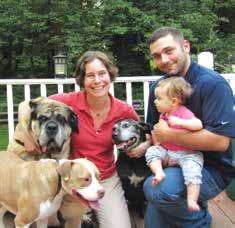
Two years ago, Johnson had their first child, a daughter. And she is pregnant with their second, a son, due this spring. She is grateful for the “very supportive” atmosphere at New Bolton Center for parents of young children.
Another member of the family is October Surprise, “Toby,” an off-the-track Thoroughbred gelding Johnson bought in 2008 when he was three years old. A handsome, dark bay horse, she first rode him over miles of open countryside during a paperchase at Fair Hill, a ride set up by colleague and friend Nolen-Walston.
Characteristically, she was determined to accomplish the challenge. “I had never ridden a racehorse, never re-trained a Thoroughbred,” Johnson said. “He’d never been mounted from the ground before, but I got on him anyway and headed off.”
18 BELLWETHER SPRING 2015
DENTISTRY THAT MAKES A DIFFERENCE
Dr. Maria Soltero-Rivera’s unexpected path leads to inspiring outcomes
BY MANASEE WAGH
DR. MARIA SOLTERO-RIVERA
NEVER IMAGINED SHE WOULD BE SO INSPIRED BY THE WORDS OF A CHILD PLAYING WITH A DOG.
Last October, she organized the Best Friends Bash—a chance for young patients at Children’s Hospital of Philadelphia to socialize with dogs at Penn Vet bearing similar craniofacial conditions. A specialist in dentistry and oral surgery, Soltero-Rivera was deeply moved by witnessing the smiles on the children’s faces as well as the profound connections between human and animal health.

“We were doing interviews for a video about the event, and they asked one little girl what was the most important thing she learned. She said people have to realize that different is good. That phrase stuck in my head. It’s absolutely true,” Soltero-Rivera said.
Her colleagues know her as a veterinarian who is equally gifted in technical knowledge
WWW.VET.UPENN.EDU/BELLWETHER 19
Her colleagues know her as a veterinarian who is equally gifted in technical knowledge and in showing compassion for animals and families, which made her the natural choice to take the helm of the Best Friends Bash.
Described as a model resident and talented researcher, she is on the fast track to becoming a leader in her field.
and in showing compassion for animals and families, which made her the natural choice to take the helm of the Best Friends Bash. Described as a model resident and talented researcher, she is on the fast track to becoming a leader in her field.
Soltero-Rivera has been interested in veterinary medicine since high school in Puerto Rico, but she initially thought she would focus on farm animals. “In my undergraduate studies in animal sciences, I learned about production animals. I really enjoyed being out on the farms in Puerto Rico. It’s very peaceful,” she said.
While in vet school, she volunteered with Dr. Marilucy Quinones, a small animal surgeon who started the first specialty vet practice in Puerto Rico. That’s when Soltero-Rivera realized she wanted to help companion animals. “Dr. Quinones was able to provide me with a well-rounded experience, including dentistry, and the experience was life changing,” she recalled.
At Cornell University College of Veterinary Medicine, where she earned her DVM in 2008, Soltero-Rivera delved into dentistry with Dr. Jennifer Rawlinson, who had done her residency at Penn Vet and later started the animal dentistry service at Cornell.
“She is the whole reason I love dentistry. She showed me how fun it is,” said SolteroRivera. She added that Drs. Quinones and Rawlinson are inspiring role models,
because they are stellar veterinarians who also successfully juggle the responsibilities of being wives and mothers.
“Then I came to Penn for my residency and absolutely fell in love with the place,” she said. She has been at Penn Vet since July 2010.
Soltero-Rivera’s mentors, who are now her colleagues, quickly grew to appreciate her as well. One of them, Dr. Alexander Reiter, challenged her to succeed.
Reiter, head of the Dentistry and Oral Surgery Service at Penn Vet, said he pushes his students to perform at the highest level. He described Soltero-Rivera as “a model resident” due to her exceptionally strong and broad foundation of theoretical and practical knowledge, combined with genuine compassion for pets and owners.
He added that Soltero-Rivera invites collaboration, an important skill for advancing research in the field. Also an excellent teacher, Soltero-Rivera communicates equally well in front of students or experienced professionals at international conferences.
“During her first visit to Penn, her love for teaching became obvious when she volunteered to help teach a physical exam lab for first-year students, right after her interview. That raised our interest in her right away,” Reiter said.
In the 1970s, Penn’s veterinary school became the first in North America to offer an organized program in veterinary dentistry and oral surgery. The Dentistry and Oral Surgery Service at Ryan Hospital is considered a world leader for teaching, research, and clinical work.
“You can make such a big difference in an animal’s life by taking care of the oral cavity,” said Soltero-Rivera. She noted that when a general practice pays attention to dentistry, it’s a sure indication of attention to detail.
Her department, employing three residents, is immersed in researching potential new therapies as well as providing daily care for animals.
“We treat anything from gingivitis in a dog or cat, to tumors in older animals, to puppies with cleft palates. We can diagnose and treat medical problems with salivary glands. Our service involves endodontics, periodontics, oral surgery, restoratives, and prosthodontics,” explained Soltero-Rivera, adding, “I like that I don’t do same thing
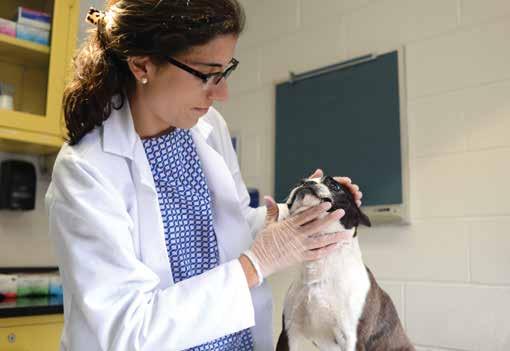
20 BELLWETHER SPRING 2015
every day. I treat animals, do research, and teach.”
One research area that shows promise is regenerative medicine, particularly stem cell therapy to treat inflammatory conditions in cats and other animals. Drawing upon Penn Vet’s commitment to One Health—pursuing collaborations that connect human, animal, and environmental health—Soltero-Rivera is investigating the new technique with Dr. Anh Le, Chair and Norman Vine Endowed Professor of Oral Rehabilitation, and senior investigator Dr. Qunzhou Zhang, both of Penn’s School of Dental Medicine.
Current treatment methods for inflammatory conditions involve surgery and medications. Feline gingivostomatitis, which causes inflamed gums and oral mucosal tissues in cats, is typically solved by performing full mouth extractions.
“It does the trick in about 80 percent of patients, but it would be ideal to do something less invasive,” Soltero-Rivera said, adding, “We’re very early in our work in stem cell therapy. But stem cells have been proven to have immunomodulating effects.”
If it comes to fruition—a process that could take several years of research and trials—this therapy could treat not only stomatitis but also periodontal disease and autoimmune diseases in the oral cavity. About 80 percent of animals seem to have some form of periodontal disease, manifested as mildly as redness of the gums or as severely as losing teeth or even fracturing a jawbone.
Similar stem cell therapy techniques are already used to some extent in people to treat inflammatory bowel disease and Crohn’s disease, both of which cause inflammation of the gastrointestinal tract.
Soltero-Rivera says her department has also pursued an increasing number of craniofacial reconstructions. Pet owners from all over the country come to Penn Vet for palatal repairs for their animals.
“We’re finding new things to try, and we’re improving our procedures. We’re fixing bigger defects,” she said. One of Penn Vet’s most advanced periodontal procedures is guided tissue regeneration, which involves rebuilding the supporting structures of the teeth.
“I’m also collaborating with Dr. Melissa Sanchez in the pathology department to better research disease progression. We’re
trying to advance the knowledge of disease processes that haven’t been described well before,” Soltero-Rivera said.
Among Penn Vet’s recent successes is the cleft palate surgery for Lentil the bulldog in 2013. Lentil became a media darling whose story was avidly followed all over the Internet, and his case has drawn clients for cleft palate repairs from as far away as Utah and Idaho, says Soltero-Rivera.
An “ambassadog” of sorts for overcoming craniofacial problems, Lentil’s story inspired the Best Friends Bash—a celebration that took place at Penn Vet’s Hill Pavilion in 2013 and at CHOP in 2014. A social, therapeutic occasion for children with craniofacial conditions and their families, the party exemplifies the One Health mission of connecting animal and human health.
Soltero-Rivera is excited to continue the work of the Best Friends Bash. She inherited leadership of that initiative from one of her Penn Vet mentors, Dr. John Lewis, then an Associate Professor of Dentistry and Oral Surgery. “I was fortunate to take the reins on this effort. It keeps growing every year,” she said. It’s an effort that’s grown close to her heart.
Lewis, who is now at NorthStar VETS in Robbinsville, New Jersey, said it was easy to pass the responsibility to her: “She’s been a great asset to the University ever since she was a resident. It was obvious she was a gifted clinician and a talented oral surgeon, and just an overall wonderful person.”
This year, both dogs and children attending the bash wore superhero capes, and the kids shared trading cards with facts about the dogs they were meeting.
The animals Penn Vet finds for the party are trained to comfort children who are going through similar craniofacial procedures. There was a dog that had part of his upper jaw removed, and dogs with multiple tooth extractions and scars.

“We introduced them to the kids and talked about each one of them,” explained Soltero-Rivera. “These kids are normally very shy, but when you put them in a room together like this with dogs, they just come out of their shells. It’s a day when they don’t have to feel different.”
And, as one young patient observed, it may also be a day to learn that different can be just fine.
“These kids are normally very shy, but when you put them in a room together like this with dogs, they just come out of their shells.”
WWW.VET.UPENN.EDU/BELLWETHER 21
SCAVMA AUCTION


(Above and right) Penn Vet’s Student Chapter of the American Veterinary Medical Association (SCAVMA) held a carnival-themed auction this year to raise money for the organization. Students, faculty, staff, donors, alumni, and parents donated a variety of items for the silent and live auctions. Many of the student clubs were represented, selling raffle tickets and food. Proceeds from the auction allow SCAVMA members to attend conferences and symposia throughout the year.

BEST FRIENDS BASH
(Below) The Children’s Hospital of Philadelphia hosted the second annual Best Friends Bash for 15 of their craniofacial patients. The children had the opportunity to meet dogs with similar conditions that had been treated by experts in Ryan Hospital’s Dentistry and Oral Surgery Service. This unique partnership aims to help children see how dogs are affected by similar problems and how they have adapted.


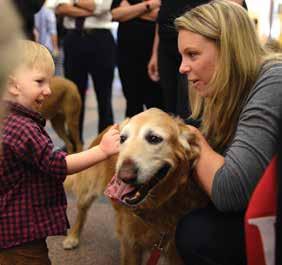
22 BELLWETHER SPRING 2015 EVENTS
MICROBIAL COMMUNITIES IN HEALTH AND DISEASE SYMPOSIUM
(Top left) Author and New York Times columnist Carl Zimmer discussed “A Planet of Viruses: How Humans Can Live Safely on a Viral World” at the public opening of the symposium. The two-day event explored how bacteria, parasites, viruses, and other organisms interact with their animal and human hosts in ways that either maintain health or lead to disease.

ONE HEALTH AWARD
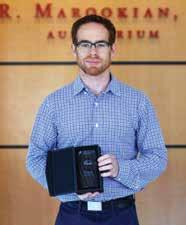
(Top center and right) Dr. Eric Goren of Penn’s Perelman School of Medicine was the 2014 recipient of Penn’s One Health Award, in recognition of his exemplary contributions to expanding interdisciplinary education and improving health care. Penn’s “Bridging the Gaps” program was also honored for excellence in interprofessional service and education.


CELEBRATION OF WOMEN FACULTY

(Middle row) Penn Vet hosted the Penn Forum for Women Faculty’s 5th Annual Celebration of Women Faculty. The Forum advocates for policies and practices that promote equity for women faculty. Deans, vice deans, and deputy deans from Penn’s 12 schools and centers gathered to applaud the many accomplishments of their respective women faculty. School of Nursing Dean Antonia Villarruel gave the Invited Remarks. Forum Past Chair Sherrill Adams led the celebratory toast.
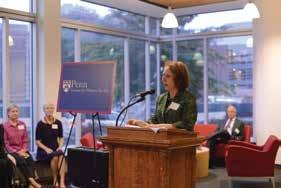
WHITE COAT CEREMONY
The Class of 2016 held their White Coat Ceremony, marking the end of their core curriculum and beginning of clinical rotations. (At right) Class President Katherine Stephens addresses her classmates.
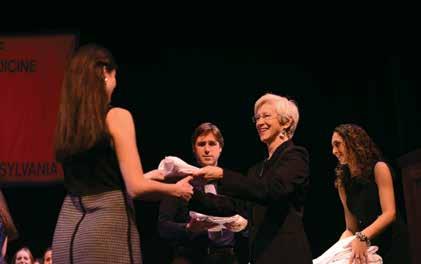
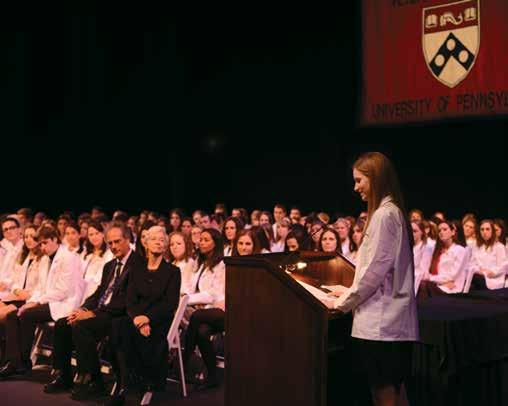

WWW.VET.UPENN.EDU/BELLWETHER 23 EVENTS
(Below) Penn Vet Dean Joan Hendricks hands out the coats.
Dr. Kendra Bence and Team Piece Together Signaling Pathway Leading to Obesity
By Katherine Unger Baillie
As scientists probe the molecular underpinnings of why some people are prone to obesity and some to leanness, they are discovering that weight maintenance is more complicated than the old “calories in, calories out” adage.
A team of researchers led by Penn Vet’s Dr. Kendra K. Bence has now drawn connections between known regulators of body mass, pointing to possible treatments for obesity and metabolic disorders.

Their work also presents intriguing clues that these same molecular pathways may play a role in learning, and perhaps even in some forms of brain cancer.
Bence, Associate Professor in the Department of Animal Biology at Penn Vet, was senior author on the work, which was published in the Journal of Biological Chemistry. Her collaborators included lead author and neuroscience doctoral student Ceren Ozek as well as Dr. Harvey J. Grill, Professor in Penn’s Department of Psychology in the School of Arts & Sciences and Director of Integrative Programs at the Institute
of Diabetes, Obesity, and Metabolism. The Penn researchers teamed with Dr. Scott E. Kanoski of the University of Southern California and Dr. Zhong-Yin Zhang of Indiana University.
Previous research by Bence and colleagues highlighted the important role of the enzyme protein tyrosine phosphatase 1B (PTP1B) in regulating body weight. They showed that PTP1B acts to counter the action of the hormone leptin, which is produced by fat cells and suppresses appetite. When mice have been bred to lack PTP1B, they remain lean even when they have unlimited access to high-fat food.
Yet other work has shown that mice lacking both leptin and PTP1B are trimmer than mice that lacked just leptin.
“That nagged at us because it clearly indicates that there are other targets than just leptin signaling for this phosphatase,” Bence said.
That sparked a search for these theoretical targets. The team knew that PTP1B has an affinity to recognize a particular sequence of amino acids. Looking for other proteins with
24 BELLWETHER SPRING 2015
RESEARCH BRIEF
this sequence, they turned up tropomyosin receptor kinase B (TrkB), a receptor in the brain that binds to a molecule called brain-derived neurotrophic factor (BDNF).
“That was interesting because mutations in the BDNF gene have been found in study after study to be strongly correlated with body mass index in humans,” Bence said.
To see if PTP1B does in fact act upon TrkB, the researchers first performed a series of experiments on neuronal cells in culture. They found that boosting expression of PTP1B suppressed BDNF and TrkB activity. Conversely, inhibiting PTP1B activity enhanced the activity of the BDNF-TrkB signaling pathway. The researchers also used biochemical assays to confirm that PTP1B physically interacts with TrkB.
Moving to mice, Bence, Grill, and colleagues gave animals bred to lack PTP1B a dose of BDNF in their brains—an action that, in normal mice, reduces appetite. Lacking PTP1B didn’t change this fact. But these mice did differ from normal mice in one important way: their core temperature. The genetically altered mice had higher core temperatures after a dose of BDNF than normal mice, an effect that correlates with increased energy expenditure—calories out—and thus causes weight loss.
“This is the first time that anyone has linked PTP1B with BDNF and TrkB in vivo,” Bence said. “And it was interesting to see that the effect on weight regulation seems to be through impacting core temperature and not food consumption.”
Finally, because BDNF is known to support the growth and survival of brain cells, the team examined whether PTP1B had an effect on that function. Inhibiting PTP1B in cultured neuroblastoma cells increased outgrowth of neuron projections called neurites, a potential indicator of brain maturation and development.
“This opens up really interesting new avenues for investigation,” Bence explained, “because Trk receptors are critically important during neurodevelopment, particularly just before and right after birth. It could be that PTP1B and BDNF are playing a role in programming the brain’s ability to regulate body weight during a critical period of brain development.”
What’s more, because BDNF is known to play a more general role in brain function, the findings suggest that PTP1B, too, may be influencing more than obesity and metabolism. Trk receptors, for example, are overrepresented in neuroblastoma—a cancer of the nerve cells that often affects children.
“The most exciting thing to me is this whole new area of investigation into the role of PTP1B regulation of all the Trk receptors,” Bence said, pointing to an area that might include explorations of the receptors’ role in neurogenesis, learning, and memory, and perhaps even neuroblastoma.
Pet Memorial Program
This research was supported by the National Institutes of Health and Penn’s Institute for Diabetes, Obesity, and Metabolism.
HONOR YOUR PATIENTS BY PARTICIPATING IN THE PENN VET PET MEMORIAL PROGRAM

Established in 1982, Penn Vet’s Pet Memorial Program helps practitioners show compassion for their clients who have recently lost a beloved pet, while providing an important contribution to Ryan Hospital. The program provides financial support for the treatment and care of Penn Vet’s animal patients.
COST • $150 for a pack of 12 cards
• 10% discount on your order of 3 packs or more
• $15 per card if we mail the cards for you
• 50% discount on your order of 10 packs or more, plus the option of sending a monthly recurring gift for payment
For more information and an order form, visit www.vet.upenn.edu/petmemorialcards-vets or call 215.898.1480.
“No one seemed to care about his death. To them he was just a skinny, old alley cat. But he was a good boy, loyal to me. I am still weeping over his passing, missing him A LOT. So, thank you for helping him at the end, thus helping me; and most especially, thank you for your gift to Penn Vet, which will ultimately help many, many more cats….”
WWW.VET.UPENN.EDU/BELLWETHER 25
RESEARCH BRIEF 25 BELLWETHER SPRING 2015
OF AN ALUMNI PARTICIPANT)
(CLIENT
‘‘
Exploring the Role of Microbes in Alcoholic


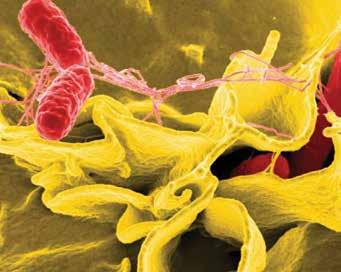
Liver
Disease, Sepsis, and Periodontal Disease

New Penn Vet Studies Made Possible by Robert and Hope Sheft
By Ashley Berke
Through Penn Vet’s Center for HostMicrobial Interactions, researchers are exploring the microbiome of animals in order to benefit both animal and human health. Three new studies will explore how microbes impact alcoholic liver disease, infections caused by Salmonella, and periodontal disease. These projects are funded by a generous gift from Robert and Hope Sheft.
“Through the generosity of the Shefts, we are able to support exciting new areas of research that have broad implications for both animal and human health,” said Dr. Christopher Hunter, Director of the Center for Host-Microbial Interactions.
26 BELLWETHER SPRING 2015
CAMPUS
UPDATES
The role of the intestinal microbiome in alcoholic liver disease
Dr. Narayan Avadhani, the Harriet Ellison Woodward Professor of Biochemistry at Penn Vet, will examine the role of the intestinal microbiome and intestinal permeability in alcoholic liver disease.
Alcohol consumption has been implicated in a range of human diseases, including alcoholic liver disease, liver cancer, and pancreatitis. Current alcohol toxicity research focuses on the enzymes that break down alcohol. However, this strategy has not been successful in understanding the mechanism of alcoholic liver disease or its treatment.
Avadhani hypothesizes that gut bacteria play a major role in causing disease by making the gut more permeable. When excess alcohol is consumed, the composition of the gut bacteria changes, compromising intestinal barrier function and allowing toxins to enter the bloodstream and cause disease.
Avadhani will study the relationship between changes in the gut communities of bacteria and gut barrier function. His research could lead to successful treatments in humans whose gut bacteria have been altered from excess alcohol consumption. By replacing the bacteria they are missing, the gut may be repaired.
The molecular mechanisms that lead to serious infections caused by Salmonella
Dr. Dieter Schifferli, Professor of Microbiology at Penn Vet, will sequence the Salmonella genome in order to determine the molecular mechanisms that cause serious septic infections in humans and livestock.
Salmonella remains the most frequent bacterial cause of foodborne disease in the U.S. and of typhoid fever in developing countries. In certain strains of Salmonella, bacteria remain in the intestine, causing mild gastrointestinal illness. In other strains, bacteria migrate from the intestine and enter the bloodstream, causing serious septic infections that can result in morbidity or even death in both livestock and humans.
The molecular mechanisms that allow bacteria to leave a host’s intestines and cause systemic infection are poorly understood. Using various strains collected from agricultural cases, Schifferli will sequence the genomes of systemic Salmonella strains to discover the genetic factors that arm these bacteria to migrate out of the gut. He aims to discover
whole pieces of the genome that are important in determining how bacteria become more or less virulent. This information could support the development of new drugs or vaccines against septicemic Salmonella.
The role of periodontal disease in the oral microbiome
Dr. Tom Schaer, Senior Research Investigator at Penn Vet’s Comparative Orthopaedic Research Laboratory, and Dr. Dipti Pitta, Assistant Professor in Ruminant Nutrition, will study how healthy microbial communities are influenced by the introduction of bacteria in order to shed new light on the cause of periodontal disease.
Periodontal disease is a chronic, progressive disease of the gums and periodontal structures that affects one out of every two American adults ages 30 and over. The disease has been associated with other chronic diseases such as cardiovascular disease and arthritis.
There is increasing evidence that periodontal disease is associated with oral dysbiosis, a change in the normal microbial population in the mouth. However, it has not been established whether changes in this complex microbial community are a driving cause, or simply a consequence, of the disease.
Schaer and Pitta will profile the bacteria that colonize the mouths of healthy miniature pigs and will compare this to the bacteria found in the mouths of miniature pigs with severe periodontal disease—a process that occurs naturally in these animals at seven to nine years of age. This spontaneous development of disease—and the fact that miniature pigs eat a diet much like humans, chew their food in a way that is similar to humans, and have a dental structure like humans—means that these animals serve as an ideal model for this research.
Using a transplantation model, Schaer and Pitta will discover how healthy microbial communities are influenced by the introduction of oral bacteria from pigs with periodontal disease. Their work would be the first to address a causeeffect relationship between oral bacteria and periodontal disease. Results from this study would lay the groundwork for a translational research platform to explore causal relationships between periodontal disease and degenerative processes in distant organ systems, such as the musculoskeletal and cardiovascular systems.
WWW.VET.UPENN.EDU/BELLWETHER 27
CAMPUS UPDATES
The projects, each led by Penn Vet faculty, will investigate the following interactions:
PennHIP
Pioneering the Diagnosis of Canine Hip Dysplasia
By John Donges
The Penn Hip Improvement Program, largely known as PennHIP, has had a fascinating and successful trajectory from lab to private sector patient care. Rigorously developed by Dr. Gail K. Smith, V’74, the program exemplifies the cross-disciplinary nature of work at Penn Vet—drawing not only from veterinary but engineering principles. But as Smith notes, “From the beginning, it’s always been about the welfare of dogs.”
Canine Hip Dysplasia (CHD) is a heritable disease that afflicts millions of dogs each year and is a major concern for pet owners, breeders, working dog owners, and veterinarians. CHD is described as the faulty development of the hip, causing excessive wear to joint cartilage; it affects all dog breeds and more than 50 percent of dogs in some of the major breeds. Excessive hip joint laxity leads to osteoarthritis (OA), stiffness, and diminished quality of life, and costs owners and breeders millions of dollars in care and loss of performance. The emotional toll is incalculable.
While CHD has been described since the 1930s, Smith’s pioneering research has advanced the ability of veterinarians to identify and treat the condition early in life. PennHIP is a unique method enabling the estimation of OA risk in dogs as young as 16 weeks of age.

PennHIP includes three major components: a diagnostic radiographic technique; a network of trained veterinarians; and a medical database for scientific analysis. The multifaceted radiographic screening method assesses the quality of the canine hip and quantitatively measures canine hip joint laxity. Approximately 3,000 veterinarians around the world are trained to perform the PennHIP methodology.
Smith charted a distinctive academic path at Penn, which led to groundbreaking work. After completing an undergraduate degree in engineering in 1970, he was interested in pursuing bioengineering, which was not an academic discipline at the time. He was accepted into the VMD-PhD program in 1971 and, after receiving his Penn Vet degree in 1974, went on to earn a PhD in materials science engineering. He completed a residency in orthopedic surgery in 1979 and was appointed to the Penn Vet faculty that same year.
As Smith explains, “I chose the veterinary curriculum over medical school because it provided more opportunity for multi-species investigation: the One Health concept.”

In the McKay Laboratory in the School of Medicine, he conducted in vitro biomechanical research on the hip, knee, and spine. In 1983, this research led to a theory that became the scientific foundation for PennHIP.
It was here that the “surgery, materials, and mechanics all came together,” Smith recalls. “We could understand hip health with a high degree of accuracy and clinical relevance.” In 1993, the PennHIP method was made available to the
28 BELLWETHER SPRING 2015
CAMPUS UPDATES
In 1996, Dr. Smith was issued a patent for the discovery; a second followed in 2013.
DR. GAIL K. SMITH, V’74
public as a clinical tool to aid in the control of CHD. In 1996, Smith was issued a patent for the discovery; a second followed in 2013.
A large scientific database houses the PennHIP data. As more information becomes available, the PennHIP laboratory is able to obtain more precise answers to questions about the etiology, prediction, and genetic basis of hip dysplasia. PennHIP publishes its findings in scientific journals to share with veterinarians, as well as breed clubs and dog fancy publications. The tools developed by PennHIP help veterinarians and dog breeders to reduce or eliminate CHD through selective breeding strategies.

With 20 years of science and 45 peer-reviewed papers to back the PennHIP findings, Smith’s work has not gone unnoticed. For his research and contributions to the advancement of small animal veterinary medicine, Smith has been recognized by the American Veterinary Medical Association and the American Kennel Club. He has also received the prestigious Blaine Award from the British Small Animal Veterinary Association and the Iams Saki Paatsama Award from the World Small Animal Veterinary Association.
In the 1990s, the Penn Center for Innovation (PCI) licensed PennHIP to a corporation, with Smith taking it back in 2002 and turning it into a not-for-profit service at Penn Vet. Recently, PCI facilitated the sale of PennHIP to Antech Imaging Services (Antech Diagnostics, Inc.): it is now called AIS PennHIP.
As the Director of AIS PennHIP, Smith helps Antech develop web-based teaching modules for an untapped market: everyday pet owners. Tom Gregor and Dr. Pamela McKelvie, longtime members of the PennHIP team, also work for AIS with Smith. Their goal is for this new educational platform to facilitate global training of new PennHIP veterinarians and to make PennHIP information accessible and convenient for dog owners, as well as breeders and vets.
“I’m looking forward to PennHIP growing rapidly,” Smith says. “Pain medication for life, even hip replacements, are compromises and cost a lot of money. People would like their dogs to have good hips. Now they’ll be able to measure the risk of their dog developing hip OA and, with their veterinarian’s guidance, implement preventive and palliative strategies early in life.”
WWW.VET.UPENN.EDU/BELLWETHER 29
CAMPUS UPDATES
PennHIP includes three major components: a diagnostic radiographic technique; a network of trained veterinarians; and a medical database for scientific analysis.
IN REMEMBRANCE
Doris B. Ritter

September 29, 1919 - December 23, 2014
Doris B. Ritter, wife of the late Dr. William B. Boucher, V’40, passed away on December 23, 2014. She and Dr. Boucher lived on the New Bolton Center campus for many years, when Dr. Boucher served as a beloved teacher and member of the New Bolton Center faculty. They are remembered by generations of students for their tremendous hospitality. They invited students, interns, and residents to their home for dinner on Thursday nights until the crowds became too large, at which time they hosted dessert instead each Thursday. In addition, they provided a picnic for the graduating class and faculty members at the close of every school year. Their house was always open to students, often providing a “home away from home” during the holidays. For years, Doris held a weekly bake sale in the New Bolton Center hospital lobby, raising funds for students. Donations may be made in Doris’ memory to the Doris and William Boucher Scholarship Fund, University of Pennsylvania School of Veterinary Medicine, 3800 Spruce Street, Philadelphia, PA 19104.
FACULTY AND STAFF NEWS
Gary C. Althouse, DVM, PhD, Chairman, Department of Clinical Studies at New Bolton Center, was recognized in August as outgoing president of the American College of Theriogenologists at the annual meeting in Portland, Oregon.
Ashley Boyle, DVM, spoke at the 2014 ACVIM Forum last June in Nashville. She also spoke at the Veterinary Comparative Respiratory Society in October, held at New Bolton Center on the topic of Complications in Strangles Infections in Horses
Samuel K. Chacko, PhD, Emeritus Professor of Pathology in the Department of Pathobiology, was appointed as a chartered member of the NIDDK-D NIH Study Section, which reviews the Institutional Training grants (T-32) and K programs for clinicians, PhDs, and graduates of health profession schools. Dr. Chacko was also appointed as an Adjunct Professor in the Department of Physiology & Pharmacology at the Drexel University College of Medicine.
Julie Engiles, VMD, was invited to present a review of equine laminitis pathology and research during the Concurrent Session on Equine Pathology at the annual national ACVP meeting in Atlanta, Georgia, this past November. This was the first time a dedicated session on Equine Pathology was given at this conference.
JD Foster, VMD, gave a lecture on Advances in Extracorporeal Therapies at the Azabu Veterinary University in Japan.
Hannah Galantino-Homer, VMD, PhD, was invited to speak at the Mid-Atlantic Hanoverian Breeders’ Club last September, and two poster abstracts were accepted at the annual meeting of the
American Society for Cell Biology in Philadelphia in December. Images generated at the Laminitis Laboratory were featured in the Larger Than Life exhibit, sponsored by the American Society for Cell Biology, at the Philadelphia International Airport from September to December 2014. In addition, the following conference oral presentation and proceedings paper was accepted for oral presentation at the American Association of Equine Practitioners Annual Convention in Salt Lake City, Utah, last December: Galantino-Homer, H.L., Clark, R.K., Linardi, R.L. “Characterization of equine hoof lamellar tissue microanatomy with fluorescent markers.” Publications included: Clark, R.K. and Galantino-Homer, H.L. Wheat Germ Agglutinin as a Counterstain for Equine Hoof Lamina Immunofluorescence Studies. Exp Dermatol. 23: 677-678; Epub 2014 July 16.
Urs Giger, Dr med vet, was an invited speaker at Columbia University, New York City, and University in Kiev, Ukraine. He was also part of a Hot Topic Panel on pet-jerky-treatassociated Fanconi syndrome with the FDA at the AVMA conference in Denver.
Ronald Harty, PhD, was invited to present a seminar entitled Controlling Ebola Virus Outbreaks: A New Strategy to Block Virus Transmission and Spread as part of the Dean’s Distinguished Speaker Series at Rowan University in Glassboro, New Jersey, last November.
Rachael Kreisler, VMD, will be speaking on the topic of a Community Approach to Veterinary Care at the Animal Care Expo on March 31, 2015, in New Orleans, Louisiana.
30 BELLWETHER SPRING 2015 CAMPUS UPDATES
REINEKE
Meryl Littman, VMD, spoke at the ACVIM 32nd Annual Forum in Nashville, TN, last June on Dips and DNA: Model Opportunities; Canine Lyme Vaccinations Revisited; and Prevalence of variant alleles associated with protein-losing nephropathy in Airedale Terriers. At the Southern Tier VMA at Cornell University in July, she presented on Lyme disease: Arthritis, nephritis, diagnosis, treatment and prevention. At the ACVIM SAIM Infectious Disease Course in Las Vegas last September, she addressed Vector-borne diseases in dogs: Update on the management of Borreliosis; Update on the management of ‘other’ Borreliosis and Anaplasmosis; Leptospirosis - Part II; Management of ‘other’ genitourinary tract infections; and Canine and feline vaccine controversies: Lyme vaccines. Dr. Littman is a member of the Pennsylvania Department of Health’s Tick and Lyme Disease Task Force.
Wilfried Mai, DVM, PhD, spoke at the Southern European Veterinary Conference in Barcelona, Spain, in October 2014, presenting several lectures on imaging in endocrinology, and instructing labs on ultrasound technique, ultrasound interpretation, challenging radiographic cases, and CT/MRI imaging cases. That same month, he also presented an abstract (oral presentation) at the American College of Veterinary Radiology in St Louis, Missouri, on CT/MRI features of carotid body paragangliomas in dogs.
Benson B. Martin, Jr., VMD, Associate Professor of Equine Sports Medicine in the Clinician-Educator track at Clinical Studies, New Bolton Center, retired after 34 years of service.
Rose Nolen-Walston, DVM, received the 2014 Lindback Award for Distinguished Teaching.
Cynthia Otto, DVM, PhD, is newly board certified in Veterinary Sports Medicine and Rehabilitation (Canine). Dr. Otto was also appointed to the National Institute of Standards and Technology OSAC Crime Scene/Death Investigation Scientific Area Committee’s (SAC’s) Dogs and Sensors Subcommittee.

Ceren Ozek, PhD, received the Ethan Sims Young Investigator Award at the Obesity Society Meeting in November 2014. The award recognizes excellence in research by young investigators based on their submitted abstracts and presentation during the Annual Scientific Meeting. The award was presented during a plenary session at ObesityWeek, where the five finalists were invited to present their oral abstracts.
Dipti Pitta, PhD, published the following: Pitta DW, Parmar N, Patel AK, Indugu N, Kumar S, Prajapathi KB, Patel AB, Reddy B, Joshi C. Bacterial diversity dynamics associated with different diets and different primer pairs in the rumen of kankrej cattle. PLoS One. 2014 Nov 3;9(11):e111710. doi: 10.1371/journal.pone.0111710. eCollection 2014. Pitta DW, Pinchak WE, Dowd S, Dorton K, Yoon I, Min BR, Fulford JD, Wickersham TA, Malinowski DP. Longitudinal shifts in bacterial diversity and fermentation pattern in the rumen of steers grazing wheat pasture. Anaerobe. 2014 Jul 31;30C:1117. doi: 10.1016/j.anaerobe.2014.07.008. [Epub ahead of print]; Pitta DW, Kumar S, Vecchiarelli B, Shirley DJ, Bittinger K, Baker LD, Ferguson JD, Thomsen N. Temporal dynamics in the ruminal microbiome of dairy cows during the transition period. J Anim Sci. 2014 Sep;92(9):4014-22. doi: 10.2527/jas.2014-7621. Epub 2014 Jul 14.

Virginia B. Reef, DVM, was the 2014 recipient of the Robert Whitlock Award, given to the faculty member who has demonstrated the most dedication to mentoring of young faculty.
Erica Reineke, VMD, spoke at the 11th Emergency and Critical Care UK Annual Congress last November. Recent publications include: Hall K, Holowaychuk M, Sharp CR, Reineke EL. A multicenter 8-week prospective cohort study of 301 dogs sustaining trauma. J Amer Vet Med Assoc 2014; 244(3):300-308; Proulx A, Hume DZ, Drobatz KJ, Reineke EL*. In vitro bacterial isolate susceptibility to empirically selected antimicrobials in 111 dogs with pneumonia. J Vet Emerg Crit Care 2014; 24(2): 194-200; Goic J, Reineke EL, Drobatz KJ. A comparison of rectal and axillary temperature measurements in dogs and cats. J Amer Vet Med Assoc 2014; 244(10):1170-1175; and Pratt C, Reineke EL, Drobatz KJ. Sewing needle foreign bodies in 65 dogs and cats: 2000-2012. J Amer Vet Med Assoc 2014; 245(3):302-308.
Alexander Reiter, Dipl. Tzt., became an Associate Editor for Frontiers in Veterinary Sciences (the journal’s Veterinary Dentistry and Oromaxillofacial Surgery section) last September. From July to November, Dr. Reiter gave presentations for the European College of Veterinary Surgeons in Copenhagen, Denmark; the Keystone Veterinary Conference in Hershey, Pennsylvania; the German Veterinary Dental Association and the Federation of European Companion Animal Veterinary Associations in Munich, Germany; and the Veterinary Dental Forum in Atlanta, Georgia. He also gave lectures and wet laboratories in oral and maxillofacial trauma surgery in Halmstad, Sweden and Munich,

WWW.VET.UPENN.EDU/BELLWETHER 31 CAMPUS UPDATES
FACULTY AND STAFF NEWS CONTINUED
PITTA MAI
FACULTY AND STAFF NEWS CONTINUED
Germany. Publications included: Soltero-Rivera M, Krick EL, Reiter AM, Brown DC, Lewis JR. Prevalence of regional and distant metastasis in cats with advanced oral squamous cell carcinoma: 49 cases (2005-2011). J Feline Med Surg 2014; 16: 164–169; Amory JT, Reetz JA, Sanchez MD, Bradley CW, Lewis JR, Reiter AM, Mai W. Computed tomographic characteristics of odontogenic neoplasms in dogs. Vet Rad Ultrasound 2014; 55: 147-158; Reiter AM. Open wide: Blindness in cats after the use of mouth gags (guest editorial). Vet J 2014; 201: 5-6; Reiter AM. Distinguishing between temporomandibular joint luxation and open-mouth jaw locking. EVDS Forum 2014; 2: 17-19; Fink L, Jennings M, Reiter AM. Placement of esophagostomy feeding tubes in cats and dogs. J Vet Dent 2014; 31: 133-138; Reiter AM, Soltero-Rivera M. Applied feline oral anatomy and tooth extraction techniques. An illustrated guide. J Feline Med Surg 2014; 16: 900-913.
Inés Rodriguez, VMD, has been traveling to the six regions of the Commonwealth as part of The Swine Group—which also includes Thomas Parsons, VMD, PhD, Meghann Pierdon, PhD, and Seth Dunipace, PhD—delivering well-attended presentations to veterinarians and swine producers on developments in Swine Enteric Coronavirus Diseases (SECD). They have been working in conjunction with the Regional VMO of the USDA-APHIS, who has been presenting information on the Federal SECD Control Program. The meetings have also allowed the group to disseminate information on Porcine Epidemic Diarrhea Virus (PEDV), which has had a major disease impact on the United States and Pennsylvania swine industries since it was first identified in the U.S. in May 2013.
Chris Rorres, PhD, Mathematician and Lecturer in Epidemiology in the Section of Epidemiology and Public Health, gave an invited talk entitled Mathematical Modeling of Animal Epidemics at a regional meeting of the Mathematical Association of America (MAA) last October at the University of the Sciences. The MAA, now in its 100th year, is the largest professional society that focuses on mathematics accessible at the undergraduate level.
Makoto Senoo, PhD, published the research article The carboxyterminus of p63 links cell cycle control and proliferative potential of epidermal progenitor cells in the journal Development His co-authors were Daisuke Suzuki, Raju Sahu, and N. Adrian Leu.
James Serpell, PhD, was invited to give keynote/plenary papers at the 4th Canine Science Forum in Lincoln, UK, and at the International Society for Anthrozoology Conference in


Vienna, Austria, last July. He also gave an invited paper at the Animal Behavior Society conference at Princeton University in August, and spent a week as Visiting Professor at Azabu University, Japan, in September. In October, he was invited to participate in a research collaboration at the University of Copenhagen in Denmark, and he gave an invitational lecture at the third (and final) CALLISTO conference in Brussels, Belgium. The results of his study, funded by a grant from the Morris Animal Foundation, have recently been published online: Duffy, D.L., et al., Evaluation of a behavioral assessment tool for dogs relinquished to shelters. PREVET (2014), http://dx.doi. org/10.1016/j.prevetmed.2014.10.003.
Deborah Silverstein, DVM, lectured at the European Veterinary Emergency and Critical Care Symposium, Prague, Czech Republic, in June 2014. She is also the co-editor of the Small Animal Critical Care Medicine textbook that was published last July. She published the following: Evaluation of a rapid bedside scoring system for microcirculation videos acquired from dogs. Gommeren K, Allerton FJ, Morin E, Reynaud A, Peeters D, Silverstein DC. J Vet Emerg Crit Care. 2014 Sep;24(5):554-61.
JoAnn Slack, DVM, received the 2014 House Officer Mentoring Award, given to a faculty member who has demonstrated dedication and compassion in mentoring House Officers.
Gail Smith, VMD, PhD, was an invited speaker at the World Small Animal Veterinary Association meeting in Cape Town, South Africa, where he presented the talk Global Animal Welfare Issues Relating to Orthopaedic Diseases

Gary Smith, DPhil, received the Excellence in Teaching Award, given to an outstanding full-time faculty member who has demonstrated a sincere and high level of interest in performing and advancing instruction in the professional student curriculum at Penn Vet.
Darko Stefanovski, DVM, PhD, was appointed Assistant Professor of Biostatistics, Department of Clinical Studies, New Bolton Center, in August 2014.
Jackie Watson, Technician in the Section of Reproduction and Behavior at New Bolton Center, presented a poster on A Survey of Environmental Enrichment Available for Domestic Horses at Princeton University in August 2014, as part of the annual meeting of the Animal Behavior Society.
32 BELLWETHER SPRING 2015 CAMPUS UPDATES
(GARY) SMITH SERPELL RODRIGUEZ
GRANTS
Gustavo Aguirre, VMD, PhD, received a three-year, $219,647 AGTC: rAAV5-hCNGB3 grant for Gene Therapy for Achromatopsia: Safety and Efficacy in a Dog Model He also received a two-year, $633,477 AGTC grant for a Gene Therapy Clinical Trial for RPGRXLRP.
Michael Atchison, PhD, received a $456,000 NIH/General Med R01-GM-111384 grant from September 2014 through August 2018 to study The role of YY1 in constitutive and inducible DNA loop formation
Narayan Avadhani, PhD, received a five-year, $1,000,000 NIH/1RO1 AR067066-01 grant to study Ahr and osteoporosis
Tracy Bale, PhD, received a two-year, $279,998 NIH/Mental Health R21-MH-104184 grant for Maternal stress and the vaginal microbiome: Impacts on brain development

William Beltran, DVM, PhD, received a five-year, NIH/NEI grant of $1,180,215 (Penn Vet sub-award) for Photoswitchable channel blockers for treatment of blindness This is a multiinstitutional (University of Washington, University of CaliforniaBerkeley, and Penn Vet) project aimed at testing and selecting optochemical compounds for the treatment of patients with end stage retinal degeneration. The goal is to identify in small and large (dog) models photoswitches capable of rendering non-photoreceptor cells of the retina photosensitive; to select the best compound based on its efficacy and safety profiles; and to file an Investigational New Drug (IND) application to plan future clinical trials in human patients. The Beltran Lab will also collaborate with Gustavo Aguirre, VMD, PhD Dr. Beltran also received a $198,585 FDN Fighting Blindness grant from September 2014 through August 2017 for the subcontract Development of Optogenetic tools with increased light sensitivity for vision.
Kendra Bence, PhD, received a $1,440,000 NIH-NIDDK grant for Neuronal Protein Tyrosine Phosphatases in Metabolism The grant spans from September 2014 through June 2018.
Dorothy Brown, DVM, received a two-year, $51,200 grant from AlcheraBio LLC for Clinical Study: A dose ranging study to evaluate the field safety and effectiveness of a single intraarticular injection of CNTX-4975 in companion animal dogs with chronic, moderate-to-severe stifle joint pain associated with osteoarthritis.
Gudrun Debes, DVM, received a one-year, $47,244 grant from the American Association of Immunologists to study The role of T cell egress from the effector site in regulating inflammation
JD Foster, VMD, received a one-year, $12,000 grant from the American Kennel Club to fund the evaluation of Fenoldopam CRI effects on glomerular filtration rate and renal sodium excretion in normal dogs. The study will evaluate whether fenoldopam may be a beneficial therapy for dogs with acute kidney injury and decreased urine output. Project collaborators include Kristen Kelly, DVM, and Kenneth Drobatz, DVM
Qi Fu, graduate student in the Laboratory of P. Jeremy Wang, MD, PhD, received a three-year, $128,028 NIH/NICHD F31 grant to study The function of MOV10L1 in piRNA biogenesis.
Ciara Gimblet of the Laboratory of Phillip Scott, PhD, received a $128,793 NIH/NIAID F31 grant from September 2014 through July 2017 for Understanding the role of IL-22 in cutaneous leishmaniasis
Robert Greenberg, PhD, received a two-year, $275,000 NIH R21-AI-112713 grant for A strategy for point-of-care molecular detection of parasitic helminth infections

Ronald Harty, PhD, received a $238,838 NIH R41 AI113952 grant to study Development of Small Molecule Therapeutics Against RNA Viruses The grant spans from April 2015 through March 2016, and his collaborators include Penn Vet’s Bruce Freedman, VMD, PhD, and Drs. Jay Wrobel and Allen Reitz of Fox Chase Chemical Diversity Center.

Brett Kaufman, PhD, received a $1,740,000 NIH NIGMS grant from January 2014 through September 2019 for Molecular mechanisms of mitochondrial DNA deletion formation
Rachael Kreisler, VMD, received a $53,524 grant from the Stanton Foundation from January through December 2015. She was awarded the ‘Next Gen’ Career Development Canine Research Fellowship to study Economic Reasons for Dog Surrender to Animal Shelters She will collaborate with James Serpell, PhD
Michaela Kristula, DVM, received a one-year, $20,581 grant from Merck Animal Health for a pilot assessment of four hydrogel teat sealant formulations in dairy cattle.
WWW.VET.UPENN.EDU/BELLWETHER 33 CAMPUS UPDATES
FOSTER BROWN AGUIRRE
GRANTS CONTINUED
Carolina Lopez, PhD, received a four-year, $1,000,000 NIH NIAID R01-AI083284 grant for A Novel Virus-Derived Adjuvant She also received a one-year, $43,680 grant from the American Association of Immunologists for Molecular Mechanisms Behind the Potent Immunostimulatory Activity of Defective Viral Genomes

Nicola Mason, BVetMed, PhD, received a one-year, $60,000 grant from Aratana Therapeutics for evaluation of AT-014 in the treatment of canine osteosarcoma.
Thomas Parsons, VMD, PhD, received a $31,483 Commonwealth of PA-USDA Swine grant from July 2014 through September 2015 for Enteric Coronavirus Disease Cooperative Agreement He also received a one-year, $80,000 grant from the ASPCA for the research fellowship and welfare training at Penn Vet Swine, as well as a $79,573 Kraft Food Group grant from November 2014 through May 2016 for New tools for measuring welfare: Cognitive bias and sleep patterns in swine In addition, Dr. Parsons received a $30,800 PA Soybean Promotion Board grant from February 2014 through March 2015 for Anticipating the next welfare challenge: Optimizing controlled disease in loose housed sows
Shelley Rankin, PhD, received a five-year, $75,000 U18FD-005164 grant for Companion Animal and Animal Food Diagnostic Sample Analysis in Support of FDA Vet-LIRN Activities and Investigations

Erica Reineke, VMD, received a one-year, ACVIM Foundation Clinical Investigation Seed Grant of $9741.60 to focus on feline
dyspnea, emergency ultrasound, and B-natriuretic peptide. The study will evaluate the ability of an emergency cardiac ultrasound performed by veterinarians in the emergency room and a blood test B-natriuretic peptide to differentiate between cardiac and non-cardiac causes of dyspnea in cats. Project collaborators include Mark Oyama, DVM, and Melanie Hezzell, Resident in Veterinary Cardiology (co-PI), along with Kenneth Drobatz, DVM, and Cassandra Ostroski, DVM (co-investigators).
Phillip Scott, PhD, received a four-year, $1,000,000 NIH R01 AI106842 grant for Protective and Pathologic Roles for CD8+ T cells in Leishmaniasis
Makoto Senoo, PhD, received a a $352,000 (FY2014) NIH/NIAMS grant to study Intrinsic and extrinsic regulation of epidermal stem cells The grant spans from July 2014 through June 2019.

Bernard Shapiro, PhD, received a one-year, $144,000 NIH/ Child Health and Human R01-HD-061285-05S1 grant for Hormonal Imprinting Predetermines Developmental Expression of Cytochrome P450s.
Charles Vite, DVM, PhD, received a $36,800 NIH/NINDS grant from October 2014 through March 2015 for Novel Therapies for Globoid Cell Leukodystrophy It is a sub-contract with Washington University.
P. Jeremy Wang, PhD, MD, received a $780,000 NIH/NIGMS R01-GM089893 grant from August 2014 through April 2018 for Regulation of meiotic recombination in mice
34 BELLWETHER SPRING 2015 CAMPUS UPDATES
WANG LOPEZ KRISTULA
STUDENT NEWS
Sarah Colmer, V’17, received the American Association of Equine Practitioners 2014 Avenues Convention Registration Scholarship. She represented the Penn Vet AAEP chapter at the 2014 Annual Convention last December in Salt Lake City, Utah.
Gabriel Innes, V’16, is the first veterinary student to be accepted into the competitive Emerging Leaders in Science and Society (ELISS) program, presented by the American Association for the Advancement of Science in collaboration with four partner campuses: University of Pennsylvania, Purdue University, Stanford University, and University of Washington. ELISS is a leadership development program for graduate students from all fields, who work together to tackle complex societal problems. During the 15-month, extracurricular program, Innes will participate in a multi-disciplinary, multi-campus team to develop information resources and events that help local and national stakeholders address complex issues in society. Innes also traveled to Rome, Italy, last summer to work with the Food and Agriculture Organization of the United Nations.

Ashley Klein, V’16, presented a poster with her research from last summer at the ACVP Annual Meeting in Atlanta. She had collaborated on a project at Johnson & Johnson in order to study PI3K Gamma and PI3K Delta’s roles in the inflammatory process through a DSS-induced colitis model in mice. She was awarded first prize for the STP Award for her poster presentation. Her collaborators included A. Guy, J. Vegas, F. Schoetens, J. E. McDuffie, W. Fung-Leung, T. Rao, B. Zimmerman, and C. Louden.
Kelly Knickelbein, V’15, Ana Malone Oliver, V’15, and Amanda Prisk, V’15, were each awarded a scholarship by the Thoroughbred Education and Research Foundation (TERF).
Melanie Lang, V’16, was selected as the Penn winner of the Walther Leadership Award, which included an all-expensespaid trip to the Western Veterinary Conference in Las Vegas in February 2015 as well as a $1,000 award.


Annelise Myers, V’17, completed a Department of State Critical Language Scholarship in Indonesia for 10 weeks. The Critical Language Scholarship is a language and cultural immersion program that seeks to increase the number of Americans that speak critical languages, one of which is Indonesian (Bahasa Indonesia). Myers is pursuing food animal medicine and is particularly interested in public health and dairy cattle. She plans on working as a dairy veterinarian in Indonesia after graduating from Penn Vet.
Katie Wiechelt, V’17, was chosen for the Army Health Profession Scholarship program as a three-year scholarship recipient. Last May, she was commissioned into the U.S. Army Veterinary Corps as a Second Lieutenant in the reserves. This summer, she will head to the Basic Officer Leadership Course (BOLC) at Fort Sam Houston in San Antonio, Texas, to begin the process of learning how to be an Army officer. After graduation, she will be commissioned as an active duty Captain.
WWW.VET.UPENN.EDU/BELLWETHER 35 CAMPUS UPDATES
WIECHELT INNES COLMER
2018 CLASS OF
BY THE NUMBERS
123 students
39 students from Pennsylvania 12 students who participated in the Summer VETS program
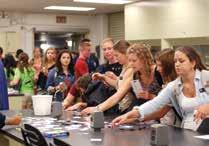
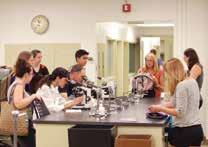
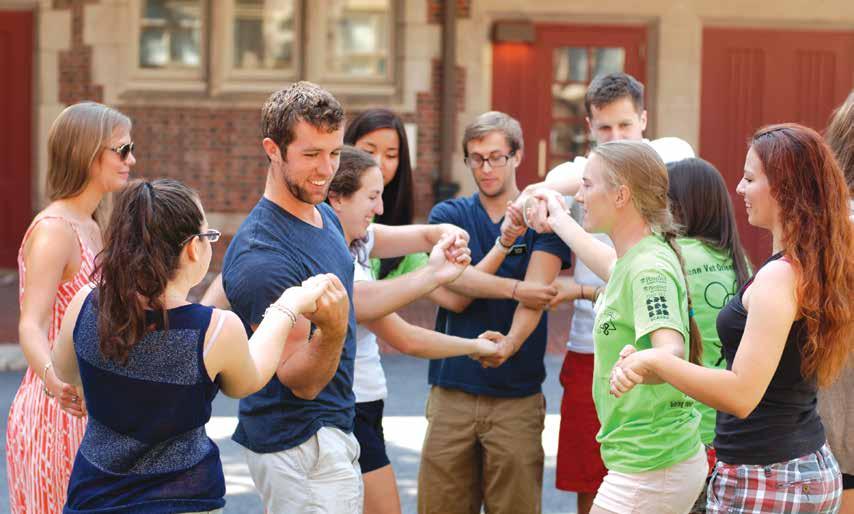
6 Penn Vet legacy students

3.57 average GPA of accepted students
73 undergraduate schools represented
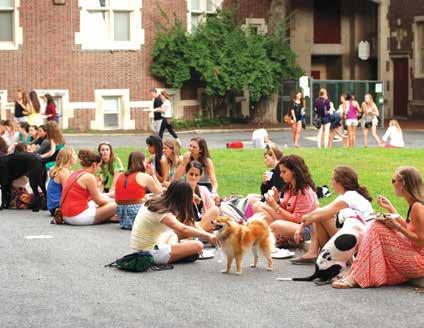

36 BELLWETHER SPRING 2015 CAMPUS
UPDATES
Dr. Midge Leitch, V’73
Dr. Midge Leitch, V’73, embodied the true pioneering spirit of many female veterinarians entering the profession at a time when it was still dominated by men. After graduating from Penn Vet, she was one of the first women to do a surgical residency at New Bolton Center and one of the first women equine practitioners to become board-certified by the American College of Veterinary Surgeons, achieving that distinction in 1982. She subsequently served on New Bolton Center’s surgical and sports imaging staff for several years and established a successful private practice.
Leitch served as an official veterinarian to the United States Equestrian Team and was an active member of the American Association of Equine Practitioners (AAEP) for more than 40 years. In recognition of her many contributions to equine medicine, she was awarded the Penn Vet Alumni Award of Merit in 1988 and the AAEP Distinguished Service Award in 2012.
In addition to her remarkable professional career, Leitch was a devoted alumna, supporting a variety of initiatives at the School. She cared deeply about helping students through the Opportunity Scholarship Program. Her numerous community and civic activities included Canine Partners for
Dr. Leitch served as an official veterinarian to the United States Equestrian Team and was an active member of the American Association of Equine Practitioners (AAEP) for more than 40 years.

Life and The Seeing Eye, for which she served as a puppyraiser until her death in early 2014.
This experience with working dogs fueled her interest in the Penn Vet Working Dog Center (WDC) when it was established in 2012, as Leitch had a unique appreciation for the value of high-quality, high-performing working dogs to society. After a visit to the Center not long after its opening, she stressed her belief in the importance of studying the genetic factors impacting working dog success.
Continuing her history of thoughtful generosity to the School, Leitch decided to leave a sizeable portion of her estate to the WDC, where it has had an immediate and direct impact on furthering the Center’s research and education goals.
ABOUT PLANNED GIVING
Over the years, Penn Vet has received generous support from many donors whose estate gifts have furthered the School’s mission by funding scholarships, professorships, hospital needs, cutting-edge research, and more. These special donors are members of the School’s Veterinary Heritage Circle and the University’s Charles Custis Harrison Society.
Bequests are one of the simplest ways to leave a permanent mark upon the School and can be directed to an area that is most meaningful to you. You can give a specific amount or a percentage of your estate to Penn Vet; you can also leave the School the amount that remains after you have taken care of family and other loved ones.
To learn more about how to make a gift through your will, or other ways to make a planned gift, please contact Jillian Marcussen, Director of Special Gifts and Board Relations, at 215-898-4235 or jillian2@vet.upenn.edu.
WWW.VET.UPENN.EDU/BELLWETHER 37
PLANNED GIVING PROFILE
Penn Vet Welcomes New Overseers

Penn Vet announces the appointment of Dr. Juan Luis Ferrer Perez, Felicia Madison Levy, Richard Lichter, and Gail Riepe to its Board of Overseers.

Overseer boards serve as bridges between Penn’s schools and centers and the community beyond campus boundaries. The President, Provost, and Board of Trustees rely heavily on these boards to help inform the work of the schools and centers.
“It is with great pleasure that we welcome four accomplished individuals to join Penn Vet’s Board of Overseers,” said Penn Vet Dean Joan Hendricks. “Drawing on their varied professional expertise, Juan, Felicia, Richard, and Gail will undoubtedly help bring Penn Vet to new heights.”
Dr. Juan Luis Ferrer Perez, V’82
Born and raised in San Juan, Puerto Rico, Dr. Juan Luis Ferrer Perez graduated from the University of Pennsylvania in 1978 and from Penn Vet in 1982. After receiving his VMD degree, he worked for three years at County Animal Clinic in New York before returning to Puerto Rico. He established Hospital de Animales Villa Caparra in Guaynabo, where he currently serves as Medical Director. Dr. Ferrer Perez served as President of the Colegio de Médicos Veterinarios de Puerto Rico in 1999 and 2010, and he has been a member of the Legislative Committee of the Colegio since 1998. He is also active with Penn’s Association of Latino Alumni. Dr. Ferrer Perez has been a loyal supporter of Penn Vet for many years. He resides in San Juan with his wife, Aileen, and two dogs, Carina and Inti.
Felicia Madison Levy
Felicia Madison Levy first became involved with Penn Vet after touring the Working Dog Center in November 2013, and she is eager to leverage her background in both biology and marketing as a member of the Board. Levy graduated from the University of Pennsylvania in 1987 and has long been an active member of the Penn community. She recently helped organize the New York Alumnae Group to provide outreach and engage alumnae in the area. Levy’s previous work experience includes positions with Cato Gobe & Associates, Zipatoni, American Express Publishing, and McCall’s Group. She has also been involved with fundraising and event planning volunteer initiatives with the 92nd Street Y Nursery School, the Trinity School, Memorial Sloan Kettering, and Birthright Israel. Levy lives in New York City with her family and their dog.
Richard Lichter
Richard Lichter is the Founder and Managing Partner of Newbury Partners, LLC, where he is responsible for managing its secondary investment activity. Prior to founding Newbury Partners, Lichter held a variety of Managing Director and Vice President positions at investment firms and banks, including Auda Private Equity, LLC and Merrill Lynch Capital Markets. He graduated with an MBA from the MIT Sloan School of Management and received an AB from Dartmouth College with Phi Beta Kappa honors. Lichter connected with Penn Vet because of his interest in canine health. He has been a generous supporter of Penn Vet’s canine leukemia and lymphoma immunological research. Lichter lives in Greenwich, Connecticut, with his family and their golden retriever, Fantine.

Gail Riepe
Gail Riepe is a longtime and generous friend of Penn Vet, and in particular, New Bolton Center. She returns to Penn Vet’s Board of Overseers, having previously served for nine years on its Executive Committee. Riepe is a graduate of the University of Pennsylvania; her passion for horses brought her to Penn Vet, where she joined the School’s Equine Advisory Committee. In 2004, she accepted the invitation to join the Board. Riepe lives in Cockeysville, Maryland, with her husband and their many dogs, horses, and chickens.

38 BELLWETHER SPRING 2015 NEW OVERSEERS
1960s
Peter Schantz, V’65, recently retired from the Centers for Disease Control and Prevention, where he worked as an epidemiologist in parasitic diseases. He lectures at Emory University’s School of Public Health.
Robert Jochen, V’66, has retired from teaching after 25 years of service to Blue Ridge Community College as an Associate Professor of Biology and Adjunct Faculty member. He has enjoyed teaching anatomy, physiology, microbiology, and biotechnology courses.
Sally Myton, V’69, retired in June 2014 after working for 45 years at the same animal hospital.
1970s
Edwin Wagner, V’77, was married on May 9, 2014.
1980s
Hilton Klein, V’80, was presented with the Joseph J. Garvey Award for accomplishments in administration, management, and support for programs relating to the care, quality, and humane treatment of laboratory animals in biomedical research. He received the award at the 65th American Association of Laboratory Animal Science meeting in San Antonio, Texas.
Margaret Bliss, V’86, is an Associate Veterinarian with Midway Animal Clinic located in Midway, Arkansas.
Dorie Cappiello, V’86, started her practice, Prospect Ridge Veterinary Hospital, 22 years ago in West Orange, New Jersey. She will be moving to a brand-new, 6,000-square-foot building in early 2015 and hopes to expand all areas of her small animal practice, including grooming, boarding, and physical therapy focusing on pain management and senior care.
1990s
Donna Dambach, V’90, was recently promoted to Senior Director, Head of Toxicology in the Safety Assessment Department at Genentech, Inc., where she has worked for over eight years.
Eileen (Taylor) Lindmeier, V’90, opened her own small animal veterinary clinic—Chalfont Veterinary Clinic, LLC, in Chalfont, Pennsylvania—after 24 years in private practice. Opened in September 2014, the clinic offers general medicine, dentistry, and surgery in a small clinic atmosphere.
2000s
Natalie (Austin) Albright, V’01, started at Santa Cruz Veterinary Hospital as an emergency doctor. She also gave birth to her son, Quinn Albright, in March 2013—just four days after moving into a new house.
2010s
Lauren (Vierheilig) Kaplus, V’12, and her husband had triplet boys on January 13, 2014. Noah, Samuel, and Jarett Jr. are an absolute joy and are doing well.
Allison Wolosz, V’12, gave birth to a baby girl, Shea Dorothy Wolosz, on June 13, 2014. She and her husband Justin are exhausted but thrilled.
In Remembrance
Dr. Jack Robbins, V’45, top racetrack veterinarian, longtime breeder of Thoroughbreds in California, and patriarch of an influential racing family, died the afternoon of November 29, 2014, at his home in Rancho Santa Fe, California. He was 93. Robbins was a past president of the Oak Tree Racing Association and the American Association of Equine Practitioners (AAEP), and he was instrumental in the founding of both organizations. He began practicing veterinary medicine at California racetracks in 1945. After helping found the AAEP in 1954, he served for 22 years on the organization’s ethics
WWW.VET.UPENN.EDU/BELLWETHER 39
ALUMNI NEWS
committee. In 1969, he was one of seven original directors of Oak Tree, the not-for-profit racing association that has been instrumental in many of American racing’s charitable efforts. He was also a member of the California Thoroughbred Breeders Association for more than 50 years, a member of The Jockey Club, and Director Emeritus of the Grayson Jockey Club Research Foundation and the University of California-Davis Center for Equine Health.
Dr. Sherman “Doc” Ames II, V’50, of Stewartsville, New Jersey, passed away on October 30, 2014—just five days shy of his 91st birthday. After a yearlong, post-graduation internship in Bedford, Pennsylvania, he returned to join his father (who also graduated from Penn) in the practice of veterinary medicine in Easton. They treated both small and large animals, from an ermine to an elephant. He was fourth in a row of family veterinarians, with his son and niece being the fifth and sixth. The Journal of the American Veterinary Medical Association published his article describing a novel surgical procedure he originated for the correction of a twisted stomach in cows. He retired in 1998.
Dr. Robert Schwartzman, V’52, died on December 28, 2014, in McLean, Virginia, after a brief illness. A former Chief of

Dermatology at Penn Vet, he was a founding member and former President of the American Academy of Veterinary Dermatology (AAVD). Dr. Schwartzman was a great friend, teacher, mentor, and surrogate dad to many, as well as an eternal Eagles fan.
Dr. Seymour Holtman, V’54, a veterinarian in Center City Philadelphia for three decades, died of congestive heart failure on March 15, 2014, at his home. He was 88. Before retiring in 1980, Dr. Holtman practiced at the Animal Hospital and, previously, at Dr. Bachrach’s Animal Hospital. Dr. Holtman served in the Army at Newton D. Baker General (VA) Hospital in Martinsburg, West Virginia, during World War II. After retiring from practice, he pursued cabinetmaking, welded iron sculpture, and stained-glass work, turning the same dexterity he showed as a surgeon into artistic handiwork.
Dr. Kurt A. Schilling, V’54, passed away on May 1, 2014, at the age of 89. He was a prominent veterinarian in Tarzana, California, for over 50 years, well known for an infectious chuckle and a very quick wit. Dr. Schilling served his community as a Rotarian since 1956 and was a member of the Southern California Veterinary Medical Association. His service as a Navy corpsman in World War II inspired his interest in medicine.

alumniweekend PENN VETERINARY MEDICINE MAY2015 Save the Date for Your Class Reunion May 15-17, 2015 Reunions for classes ending in a “5” or a “0” Mark your calendar to celebrate with your Penn Vet classmates! Activities include class dinners, tours of New Bolton Center and Ryan Hospital, a Dean’s Reception, a Spring Alumni Picnic on the New Bolton Center grounds, and much more! Watch the Alumni tab at www.vet.upenn.edu for more information. www.vet.upenn.edu ALUMNI NEWS
Dr. Millard M. “Mac” Mershon, V’55, passed away on August 3, 2014, at age 85. Mac practiced veterinary medicine for two years in Western Maryland, followed by three years in charge of a veterinary laboratory for the University of Maryland. He spent the next 33 years working as a toxicologist and pharmacologist for the U.S. Army at Edgewood Arsenal (now Edgewood Area of Aberdeen Proving Ground) in Maryland. During his long and distinguished career, he was responsible for countless innovations, inventions, and contributions to the science of chemical warfare defense. His research still provides much of the foundation for protecting our troops against the threats of chemical war. After retiring from the civilian work with the Army, Mac did research for Science Application International Corporation on topics such as the impact of the use of the plague germ as a biological warfare agent. He also reviewed and evaluated current research on the treatment of breast and prostate cancers.
Dr. Gerald Lewis, V’58, of Kyle, Texas, died on November 11, 2014, at age 82. A mixed practice veterinarian, he worked in Greensburg, Pennsylvania, as an associate veterinarian before purchasing The Spencerville Animal Hospital in Ohio. In 1968, he established The Amanda Animal Hospital in Spencerville, Ohio, where he worked with farm, pet, and exotic animals until his retirement in 1997. He was active in the Ohio Veterinary Medical Association and was an honorary lifetime member of the American Veterinary Medical Association. He also raised Polled Hereford cattle, was an avid birdwatcher and an amateur musician. He traveled extensively after retirement, visiting every continent and over 60 countries.
Dr. Nicholas Fisfis, V’61, age 79, passed away peacefully on January 2, 2015. He was a respected and dedicated veterinarian at South Hills Animal Hospital for 50 years until retiring last July. Dr. Fisfis was active with the Pennsylvania Veterinary Medical Association, the American Veterinary Medical Association, and the American Animal Hospital Association. He was a proud Army veteran who served his country from 1962-1964 as a First Lieutenant and was discharged as a Captain.
Dr. Wilbur Durbin Donahue, V’62, age 76, passed away on August 4, 2014, after a long battle with cardiac and lung disease. Throughout his 35-year career, he provided veterinary care to thousands of pets. He enlisted in the U.S. Army and obtained the rank of Captain in the U.S. Army Veterinary Corps. In 1968, Dr. Donahue founded the Churchland Animal Clinic in Portsmouth, Virginia, and later founded the North Suffolk Animal Clinic in Suffolk.
Dr. Asa Harris Mosher, V’62, age 78, of Salford Township, Pennsylvania, passed away at his residence on August 27, 2014, surrounded by his loving family. He was employed as a veterinary pathologist for Johnson & Johnson Pharmaceuticals for 27 years prior to his retirement in 1998. Following high school, he graduated from the University of Delaware in 1958, the University of Pennsylvania School of Veterinary Medicine in 1962, and earned his PhD in 1968 from the University of Connecticut. He enjoyed being outside and spending time with his cows, and he was known for having one of the largest fullblood Limousin herds in the country.
Dr. Fredric Baff, V’63, of Newtown, Connecticut, passed away on August 8, 2014, at age 75. Dr. Baff was the owner of Plumtrees Animal Hospital in Danbury, Connecticut, for over 30 years. He enjoyed boating and golf, but above all, helping people and their pets. He will be remembered as a wonderful teacher, a loyal companion, and a trusted caregiver.
Dr. Peter Ihrke, V’72, passed away in late February 2014. With the support and strength of his wife, Dr. Thelma Lee Gross, he fought a valiant battle against the cancer diagnosed in 2012. Dr. Ihrke completed a residency in dermatology (‘74) at Penn. He was a Diplomate of the American College of Veterinary Internal Medicine (dermatology) and then became a Diplomate of the American College of Veterinary Dermatology (ACVD). He joined the faculty at UC Davis in 1977 in the Dermatology Service and held an Adjunct Clinical Associate Professor of Dermatology position at Stanford University School of Medicine. Dr. Ihrke was an internationally recognized expert in the arena of veterinary dermatology. His research focused on skin diseases in all species with an emphasis on infectious and immunologic skin diseases. Dr. Ihrke served as president of all three of the North American organizations of veterinary dermatologists and allergists: the American College of Veterinary Dermatology, the American Academy of Veterinary Dermatology, and the Academy of Veterinary Allergy. He also served as president of the World Small Animal Veterinary Association.
SEND US YOUR NEWS!
Calling all VMDs and former Penn Vet interns and residents! Have you received a promotion, been married, had a baby, received an award, had a research finding, or opened a new business? Please share your news with us. Email
WWW.VET.UPENN.EDU/BELLWETHER 41
ALUMNI NEWS
the Alumni Office at kmcmul@vet.upenn.edu or write to us at Alumni Relations, Penn Veterinary Alumni Office, 3800 Spruce Street, Suite 172E, Philadelphia, PA 19104.
DEAN’S ALUMNI COUNCIL WELCOMES NEW MEMBERS
Captain Victoria Hampshire, V’88
Captain Victoria (Tory) Hampshire is a United States Public Health Service
Veterinary officer and currently serves as Director of Preclinical Device Review at the U.S. Food & Drug Administration’s Center for Devices and Radiological Health, Division of Cardiovascular Devices. In this capacity, she is responsible for the assessment of all animal data submitted by device manufacturers to the agency, to demonstrate reasonable safety for the purpose of receiving approval for a first-in-man clinical trial for a cardiovascular implant. She also serves as a center and agency expert on various consultations involving humane animal research, animal research regulations, animal bioethics, and drug and device safety.
Captain Hampshire started her career in private practice in Northern Virginia. At the National Institutes of Health, she served for 10 years as a biomedical research support veterinarian in clinical and program management of critically ill animal research models. She also served for several years as the principal drug safety coordinator at the FDA’s Center for Veterinary Medicine, where she had primary responsibility for monitoring side effects of all marketed veterinary drug products. Captain Hampshire has published extensively to advocate for refining animal experimentation to best support the animals; she has also highlighted that animal research is more efficient and easily applied to human settings when there is better monitoring and intervention. She has been involved in developing major agency guidance, and she also keeps in touch with routine issues by maintaining her veterinary clinical competency—moonlighting in animal hospitals within the metropolitan Washington, D.C. area.
Dr. Laurie Landeau, V’84, WG’84
Dr. Laurie Landeau, V’84, WG’84, was the first graduate of a special VMDMBA program at Penn Vet, combining the required veterinary course load with classes at Wharton to complete the fiveyear program. Landeau became a Penn Vet Overseer in 1992, serving continuously until 2005. In 2006, she graciously agreed to chair the Board through the School’s exceptionally successful capital campaign, Building New Levels of Excellence. She was appointed to the University’s Board of Trustees in 2005, serving on its Budget & Finance Committee, External Affairs Committee, and Neighborhood Initiatives Committee over the next five years. In addition to serving as a Trustee, Landeau is also a member of the Trustee’s Council of Penn Women. She rejoined the Board as an Overseer from 2009 through June 2014—bringing her years of dedicated service to the University to nearly 27 in total. Her extraordinary support of aquatic veterinary medicine at Penn Vet, as well as her leadership of Penn Vet’s Aquavet summer teaching program, demonstrates her commitment

to one of the world’s most critical food sources. As an adjunct faculty member, Landeau shared her expertise in aquaculture and aquatic veterinary medicine with countless students.

COURTYARD BECOMES CENTER OF LIFE AT PENN VET THANKS TO CLASS GIFT
In celebration of their combined 50th reunions, the Classes of 1958, 1959, and 1960 provided funding for the transformation of the central courtyard space in the Old Vet Quadrangle from a parking lot to a beautiful courtyard with green space, plantings, and seating. It is enjoyed by students, faculty, staff, and (of course) puppies and dogs of all sizes and breeds.

If those old brick walkways surrounding the courtyard could talk, they would tell an array of stories spanning decades. In 1913, when the Quadrangle was completed, the horse-drawn, small and large animal ambulances would bring patients through the archway. Today, touch football games take place on the lawn, and students study for finals at the picnic tables while enjoying some warm Philadelphia sunshine. Many activities grace the courtyard, including the new student barbecue during orientation, alumni weekend tours, and demonstrations during conferences. If these walkways could talk, they would share how happy they are that the classes of 1958, 1959, and 1960 gave this central area a whole new life.
The project began with the greening of the courtyard, which restored the large, grassy area to provide a central community space for students, staff, and animal patients and their owners. Ground level plantings were added along Classroom A, and a raised planter bed was added near the gates to create an eyecatching entrance. All are maintained on a regular basis by a professional crew.
Recent additions to the courtyard include three picnic tables— which have gotten good use from students studying for anatomy exams or enjoying time with classmates and furry friends, as well as researchers enjoying lunch while taking a break from the lab. Future plans include additional seating and a sprinkler system.
Thank you to our generous alumni who made this inviting space on the Philadelphia campus possible.
42 BELLWETHER SPRING 2015 ALUMNI NEWS
How a Simple Alumni Mapping Project Provides a Whole New Perspective
By Kristen McMullen
Iam writing this article on a flight high over the snow-covered Rockies, as I depart Salt Lake City after a terrific night at our American Association of Equine Practitioners alumni reception. We had a great evening, seeing over 70 of our alumni, as well as former residents and interns. The volume in the room was at a high decibel as old friends reconnected and guests discussed various cases and patients.
As we greeted each alum who checked in at our registration table filled with Penn Vet goodies and information, I took note of the nametags listing city and state. There is nothing like one of these trips to gain perspective on the vast reach of Penn Vet’s alumni base across the country, and even around the world.
At the beginning of my tenure as your Alumni Director, we took on a simple project of creating a visual map of where our alumni are located. These maps had legs I didn’t expect! Soon, the Dean was using them in her presentations and our governmental affairs office was including them in legislator packets.
Worldwide, our alumni span the globe from South Africa to Australia and Mongolia to the United Kingdom. Penn Vet alumni can be found in all 50 states, from New Hampshire to Hawaii and Alabama to Alaska, as well as Puerto Rico and Guam.

For those of you living at a distance from Penn, who may think you are too far away to get involved—take note. We have worked to develop three tiers of involvement: in person on campus, virtually from anywhere in the world, and opportunities where we bring Penn Vet to you at NAVC, AVMA, AAEP, and PVMA locations around the country. Alumni around the world can serve as Career Coaches for current students or as Alumni Ambassadors for their city or town. They can serve on their Class Agent team, benefit from resources through our Speakers Bureau, and much more.
On the local level, we have alumni in all Pennsylvania counties except for two. The map of our Pennsylvania alumni comes into play when we visit with local legislators to showcase the influence of veterinary medicine in the Commonwealth and, hence, why their support is so vital. Our local alumni in Pennsylvania, Delaware, New Jersey, Maryland, and surrounding states can participate in faceto-face workshops with students; take part in new student orientation and the 4th Year Sendoff Celebration; join our local Speakers Bureau; attend the SCAVMA Auction, and more. We look forward to sharing your stories in greater depth—not only where you are, but what you are doing.
And, no matter where you are in the world, we hope you will make the trip back to the Philadelphia and New Bolton Center campuses for Alumni Weekend on May 15-17, 2015, when classes ending in a “5” or a “0” will celebrate reunions. Also, as you travel to your professional conferences at NAVC, AVMA, AAEP, and PVMA, please be sure to join us at our alumni receptions for food, drink, giveaways, school updates, and to reconnect with classmates and faculty members.
No matter where you find yourself on our alumni map, we hope you will stay in touch and get involved in person or virtually. Learn more under the Get Involved tab on the Alumni pages at www.vet.upenn.edu.
WWW.VET.UPENN.EDU/BELLWETHER 43 ALUMNI NEWS
3800 Spruce Street
Philadelphia, PA 19104-6008
Penn Vet alumni and donors receive Bellwether magazine free of charge.
MARCH2015
March 11-12, 2015
Penn Annual Conference – Lectures
Sheraton Philadelphia Downtown Hotel
201 North 17th Street, Philadelphia, PA 19103
For Conference details, please visit www.vet.upenn.edu/PAC2015
March 13, 2015
Penn Annual Conference – Wet Labs
Penn Vet’s Ryan Hospital
3900 Spruce Street, Philadelphia, PA 19104
APRIL2015
April 7, 2015
First Tuesdays Lecture Series
A free educational lecture series for horse owners and horse enthusiasts
“New Points in Equine Acupuncture”
Presented by Dr. Meagan Smith
6:30 PM to 7:30 PM
New Bolton Center – Alumni Hall
382 West Street Road, Kennett Square, PA
To register, please call 610-925-6500.
MAY2015
May 5, 2015
First Tuesdays Lecture Series
A free educational lecture series for horse owners and horse enthusiasts
“Fixing Broken Horses”
Presented by Dr. Dean Richardson
6:30 PM to 7:30 PM
New Bolton Center – Alumni Hall
382 West Street Road, Kennett Square, PA
To register, please call 610-925-6500.
May 15-17, 2015
Alumni Weekend
Penn Vet Philadelphia Campus and New Bolton Center
Welcoming Penn Vet alumni with special celebrations for classes ending in ‘5’ and ‘0.’ For information, please contact Kristen McMullen at kmcmul@vet.upenn.edu or 215-898-1481.
JUNE2015
June 2, 2015
First Tuesdays Lecture Series

A free educational lecture series for horse owners and horse enthusiasts
“Treating Cancer in Horses”
Presented by Dr. Laura Johnstone
6:30 PM to 7:30 PM
New Bolton Center – Alumni Hall
382 West Street Road, Kennett Square, PA
To register, please call 610-925-6500.
JULY2015
July 13, 2015
Alumni Reception at the AVMA Convention
6:00 PM to 8:00 PM
Boston, MA
For more information on these events, please contact Darleen Calahan, Special Events Coordinator, at coles@vet.upenn.edu or 215-746-2421.
Nonprofit Organization U.S. Postage PAID Philadelphia, PA Permit No. 2563
United Way of Greater Phila. & So. NJ: #50178
calendar
Penn Vet is proud to print Bellwether magazine on FSC® (Forest Stewardship Council®) certified paper, which supports the growth of responsible forest management worldwide through its international standards.
 UNLOCKING THE MIND’S MYSTERIES DETERMINATION LEADS TO DUAL CERTIFICATION DENTISTRY THAT MAKES A DIFFERENCE
SPRING 2015 #83
THE MAGAZINE OF PENN VET
UNLOCKING THE MIND’S MYSTERIES DETERMINATION LEADS TO DUAL CERTIFICATION DENTISTRY THAT MAKES A DIFFERENCE
SPRING 2015 #83
THE MAGAZINE OF PENN VET







 BY KAREN GROSS
BY KAREN GROSS



































 BY LOUISA SHEPARD
BY LOUISA SHEPARD






























































